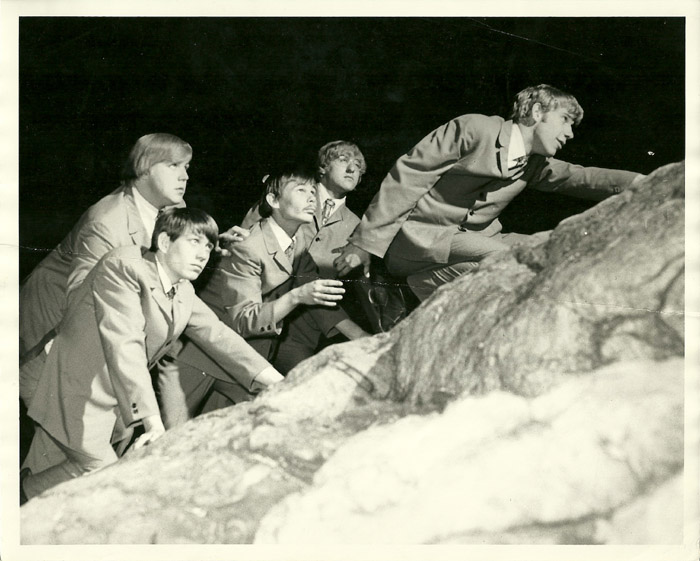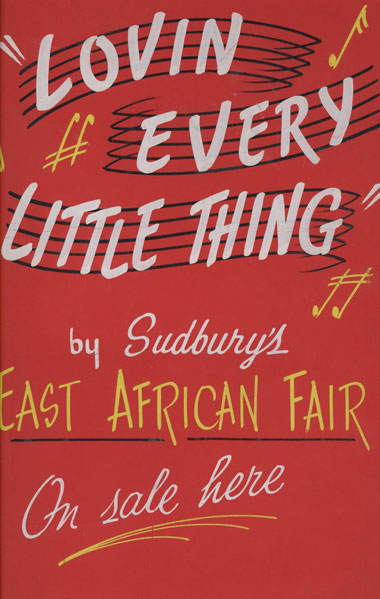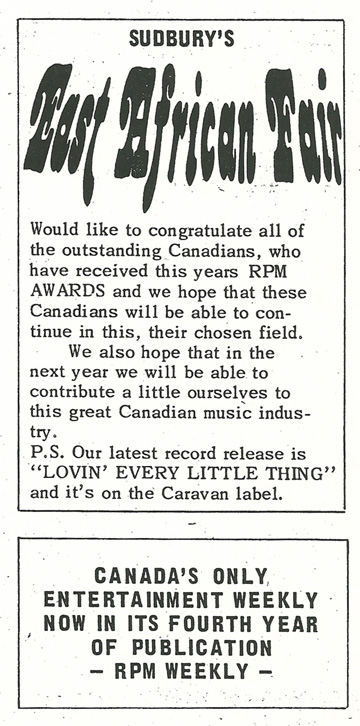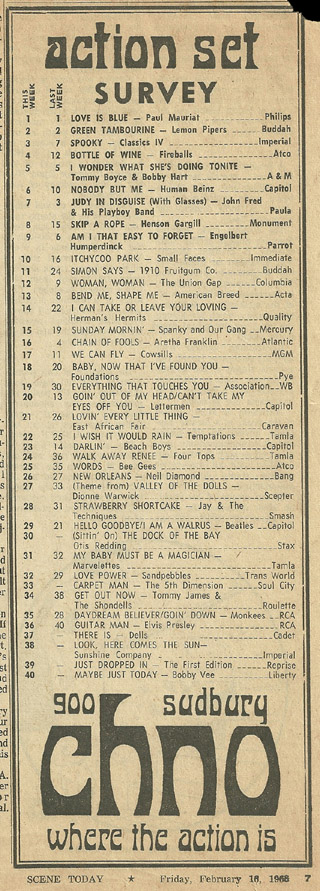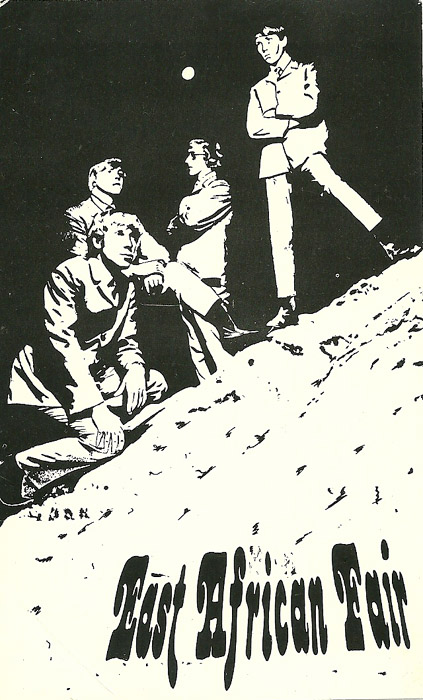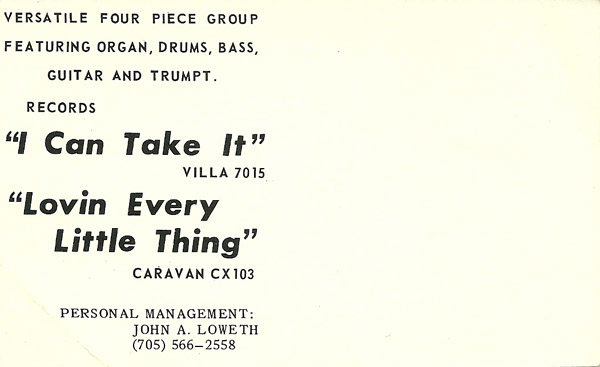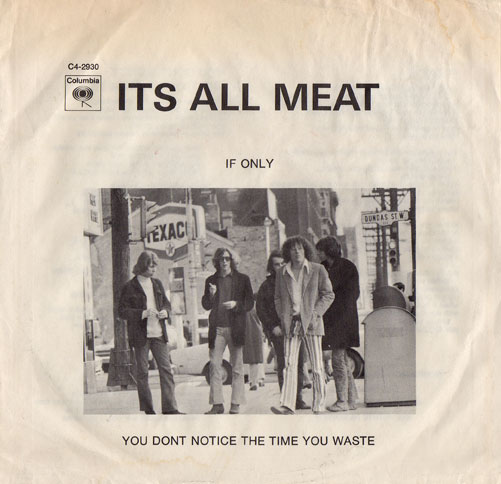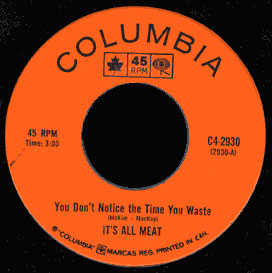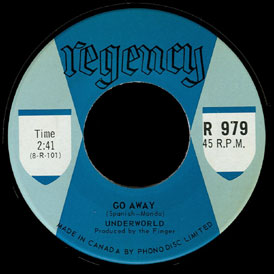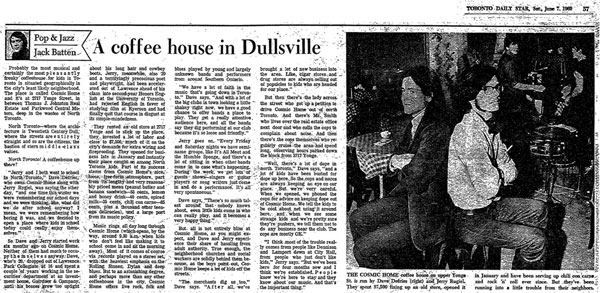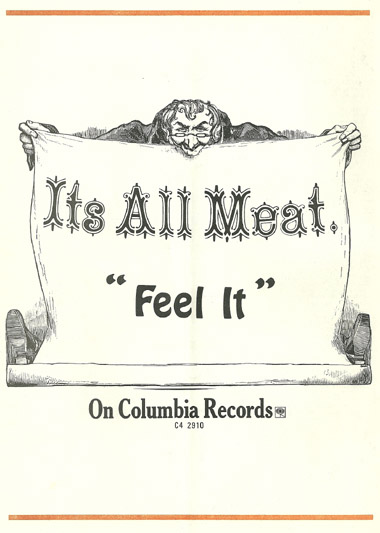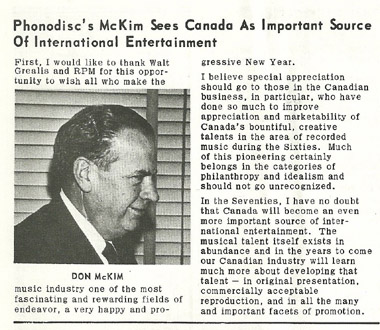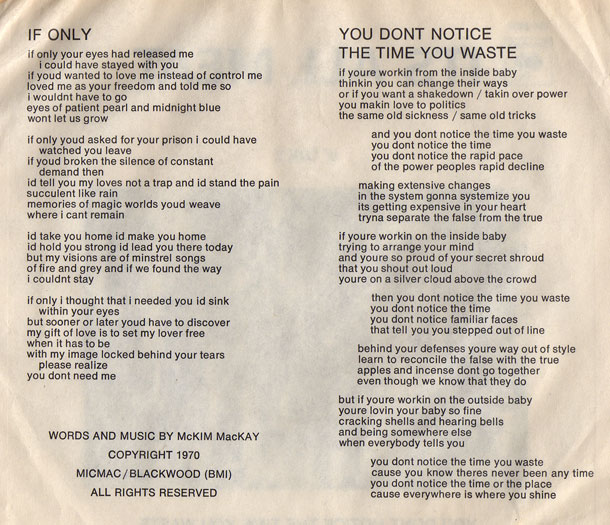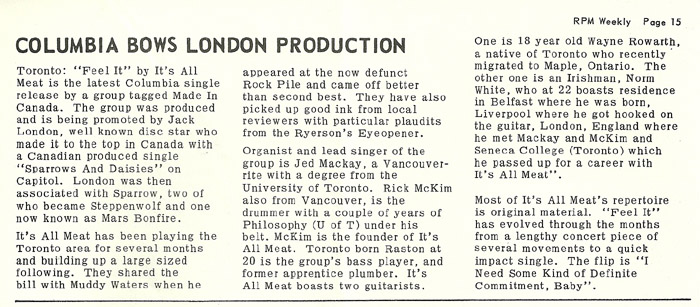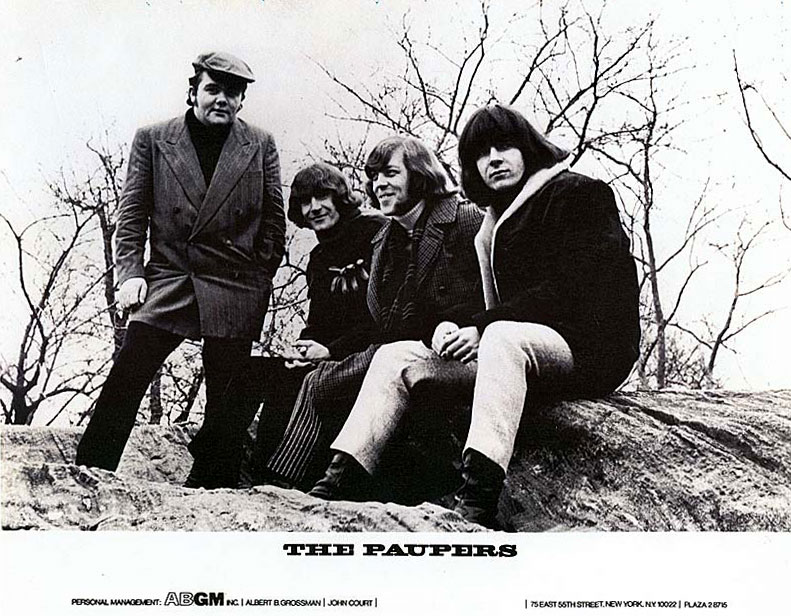
The Monterey International Pop Festival in June 1967 should have been The Paupers’ launch pad to international fame. Only four months earlier, the Canadian folk-rock band had seemed destined for the top when Bob Dylan’s manager Albert Grossman bought their contract and began hyping them as the next biggest thing since The Beatles. A month prior to the festival, the group had showcased its talent at a string of well received shows at the Fillmore Auditorium in San Francisco, and had spent two solid weeks working up a suitable set list for the forthcoming festival. As Canadian rock journalist, Nicholas Jennings notes in his excellent book, Before The Goldrush, the opportunity to “blow away the competition looked good when the band was scheduled to follow mellow popsters The Association.”
But from the minute The Paupers launched into their set, everything that could go wrong did, and in the subsequent media frenzy, the group’s performance was all but ignored. Within six months, the group once hyped to surpass The Beatles, had lost not only its most inspirational member but was facing mounting debts.
The disappointment of Monterey must have seemed a million miles away from New York’s Café Au Go Go, where, on a freezing cold evening in March 1967, The Paupers proceeded to demolish the headlining act, Jefferson Airplane, then making its East Coast debut. Performing in front of a media and record industry-packed audience that included The Beatles’ Brian Epstein and Albert Grossman, The Paupers couldn’t have picked a better time to make an impression.
While the band became the first Canadian rock band to snare a high profile American manager and a lucrative American recording contract, The Paupers never received the adulation and fame that they deserved. Along the way however, the group produced some of the finest music to emerge from Canada during the ‘60s, and live were arguably one of the most colourful, dynamic and electrifying groups on the North American stage.
The driving force throughout much of The Paupers’ career was drummer Ronn (Skip) Prokop (b. 13 December 1943, Hamilton, Ontario). An accomplished musician, Prokop had been playing music in his hometown since the age of eight when he picked up the accordion. Deserting music for two years, he took up drums at 13 after joining the Preston Scout House Drum Corps. Such was Prokop’s prowess that, according to an article in the music magazine The Canadian, he ended up becoming an instructor and worked throughout Ontario. Prokop also won the national individual rudimental championships two years in a row and composed a percussion quartet that grabbed another national award.
Boredom crept in and Prokop subsequently took up guitar. In early 1964, he formed a folk trio, The Riverside Three, but this was ditched after six months in favour of playing in a local dance band. He then formed another folk trio, but soon found himself out of work when the local hotel he was playing at discovered he was underage and passed the word around. When The Beatles and Rolling Stones-led British Invasion landed on North American shores, Prokop realised that rock was where “it” was at and moved up to Toronto to start his own band.
In an interview for Canada Music Quarterly, Prokop told journalist Joey Cee that the decision to form The Paupers was driven by his desire to put together a band that used electric 12-string guitars. The Riverside Three had toyed with the idea, but somehow had never got round to realising Prokop’s dream. Perhaps for this reason, the first person that Prokop approached to join his new project was his former cohort, singer/guitarist Bill Marion (real name: Bill Misener).
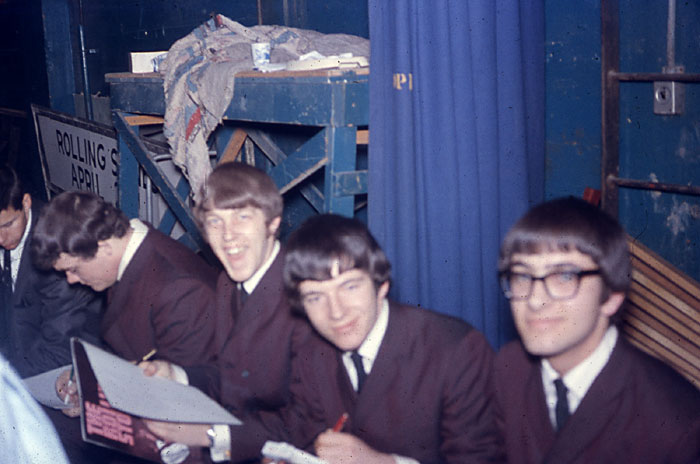
Prokop and Marion immediately got to work looking for suitable players to join their fledging group. Next to join was guitarist Chuck Beal (b. 6 April 1944, Scarborough, Ontario), who was recruited via the Toronto Musicians’ Association’s notice board. Working at Larry Sykes music in Scarborough during the day and playing the bars along Toronto’s Yonge Street strip at night, Beal was intrigued by Prokop’s concept and duly accepted the offer. Equally important, he introduced his friend, Denny Gerrard (b. 28 February 1947, Scarborough, Ontario), a self-taught guitarist, who had apparently purchased his first bass from Beal.
With Beal and Gerrard on board, and initially dubbed The Spats, the group spent two weeks rehearsing material in Beal’s basement, before venturing into Hallmark Recording Studios to lay down three Prokop originals – “Never Send You Flowers”, “Sooner Than Soon” and “Free As A Bird”. “Never Send You Flowers” duly attracted the attention of CHUM disc jockey Duff Roman, who, impressed by the song, offered to manage the band. With Roman calling the shots, “Never Send You Flowers” was released as the group’s debut single in early 1965. The single found its way to Glen Walters aka Big G Walters, a disc jockey at CKEY, and following popular demand, became the station’s top hit.
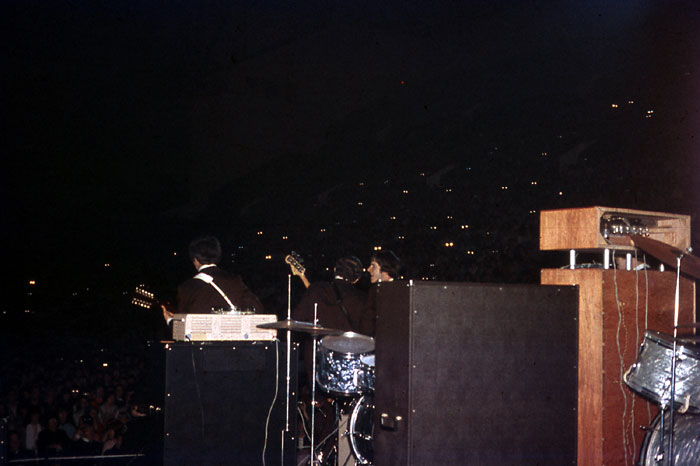

According to Beal, the sudden interest took the group by surprise. In The Canadian, he remarked: “We had all sorts of bookings coming in…and we only knew three songs. We rehearsed for another four months so we could play a show.” The band’s persistence paid off and on 25 April 1965, The Paupers (as they were now called) made only their third public performance supporting The Rolling Stones at Maple Leaf Gardens.
The decision to change the name had been thrust on the band at an early stage when another outfit in the US was found operating as The Spats. Apparently, the new name emerged on the way down to a local restaurant. “We had 50 cents among us,” Prokop told The Canadian. “Bill said, ‘Why don’t we call ourselves The Paupers’?” The name seemed rather fitting. Despite the Maple Leaf Gardens show, and regular appearances at the under 21 club in the Canadian National Exhibition during the summer, the group was virtually broke.Nevertheless, The Paupers persevered and in the autumn followed up “Never Send You Flowers” with a new single, the blues-inflected “If I Told My Baby”, which like its predecessor was issued on the local Red Leaf label.
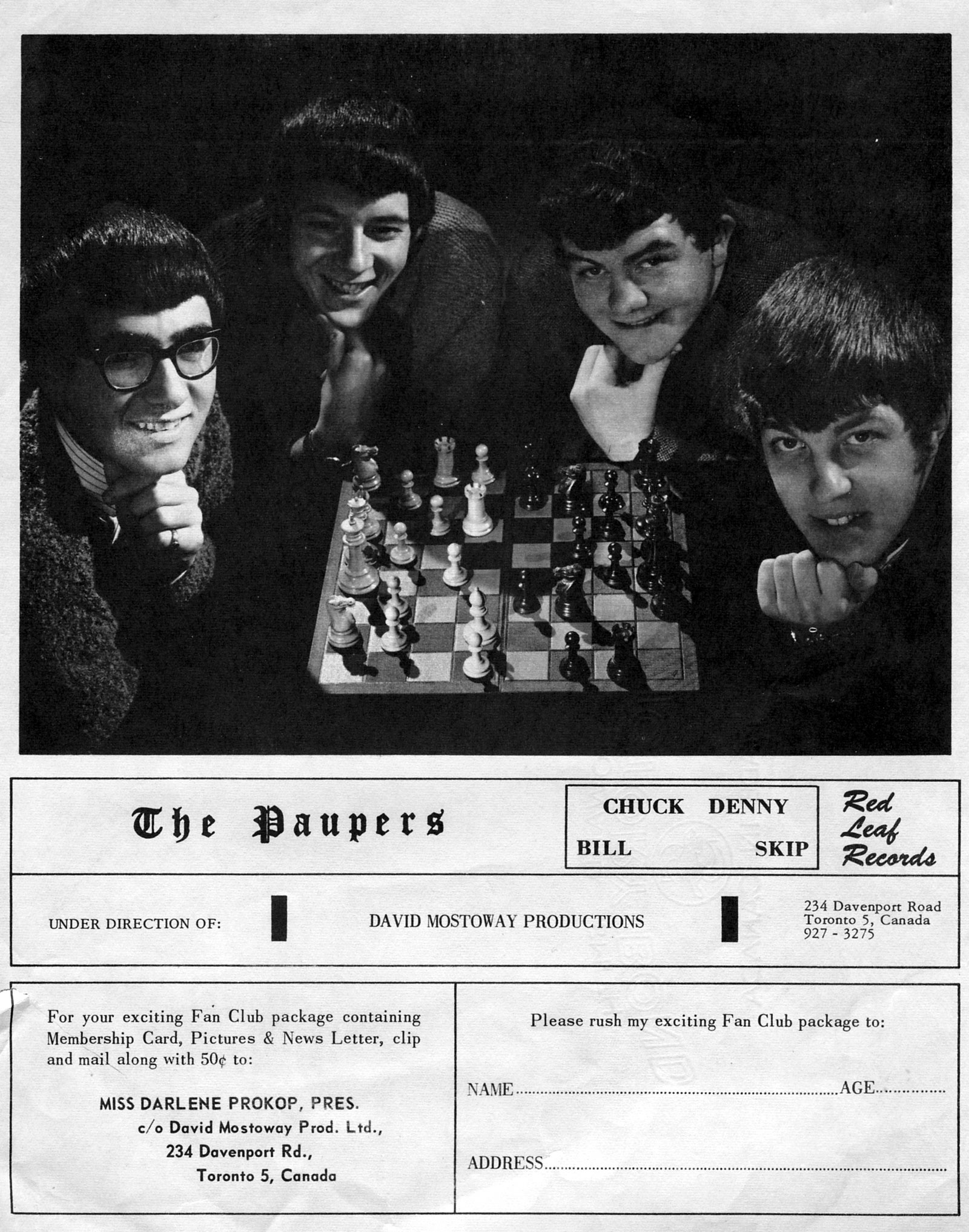
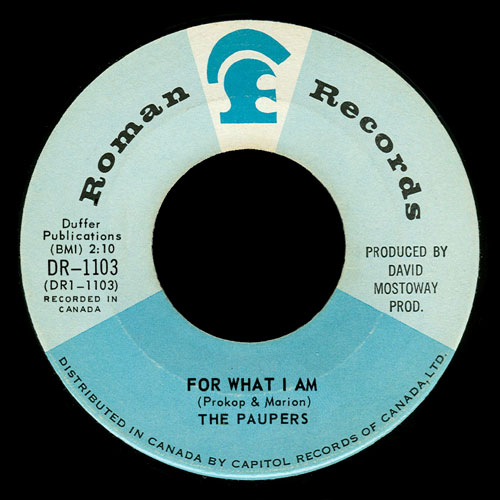
“As I recall, Red Leaf Records was formed by Duff Roman, Stan Klease (Big Town Boys’ producer), Walt Greelis (founder of RPMmagazine and what became the Juno awards) and probably some other chaps that I never met,” says Beal. “The idea was to have a nationally distributed Canadian record label that was promoted through a network of key radio stations. Canada does not have national radio stations other than the CBC and at that time, music videos were just somebody’s dream. This means that unless a bunch of radio stations across the country jump on the same record at the same time, national exposure for Canadian artists by radio was then and still is impossible. Red Leaf was a good idea but with limited financing, could not live up to the hopes of those involved.
”Not surprisingly then, “If I Told My Baby”, despite its undoubted chart potential, and a great lead vocal by Bill Marion, fell on deaf ears. The Paupers responded with the sultry “For What I Am”, which was issued on Duff Roman’s own label, Roman Records in December 1965. The song’s moody undercurrent hinted at a growing maturity in the fledging Prokop/Marion song-writing partnership, but like its predecessor it failed to chart. Perhaps for this reason, the group opted to issue a cover, “Long Tall Sally” as a follow up, but once again the Canadian record buying public stayed away.
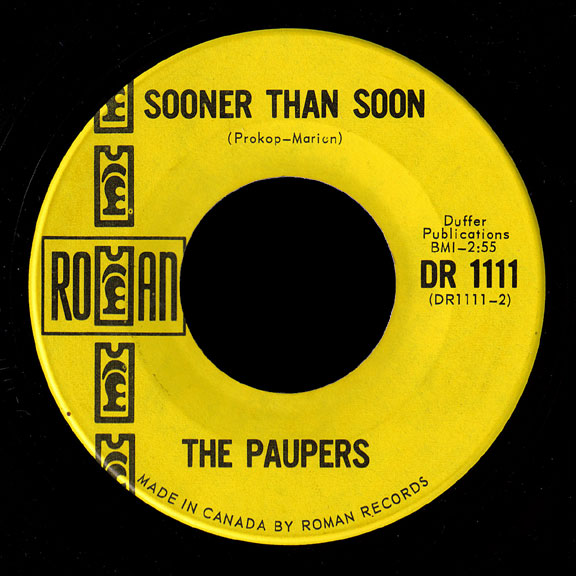
Finkelstein was an interesting character who first dabbled with managing a band while at school. Over the next few years he drifted from job to job – there are rumours that he slept in hot dog stands and laundromats, and at one point got by working as a caretaker in a local theatre. Somehow he ended up at the El Patio, making expresso coffees during the evenings, and cleaning the premises during the day. It was during an afternoon shift that he first caught The Paupers, who at the time were rehearsing for their debut weeklong engagement. Finkelstein was suitably impressed. Not one for mincing his words, he boldly told the group that the best acts around were those writing original material and immediately offered his services as a manager.
Up to this point, the group had been handling most of its affairs; apart from producing the band, Roman had little input other than acting as its publisher. However, as Prokop recalled to Ritchie Yorke in his book Axes, Chops & Hot Licks, “there had been a lot of hassles and uptightness”, and when Finkelstein arrived “with a lot of flashy ideas”, the group decided to dispense with Roman’s services.
Finkelstein’s fast-talking finesse soon got results when Arc Records offered to record the band that summer. The label, it seems, may even have got as far as putting a recording on tape. According to the Toronto Telegram’s After Four section on Thursday, 14 July, The Paupers were due to perform at the North Toronto Memorial Arena the following Tuesday where fans would get the opportunity to hear the group’s latest recording – “Heart Walking Blues”.
Whether any such recording actually made it on to the market is not entirely clear. No-one in the band seems to recall anything about this particular recording and bearing in mind that The Paupers’ were about to undergo a major upheaval in their line up, it is likely that the recording was quickly ditched with very few, if any, copies being pressed.
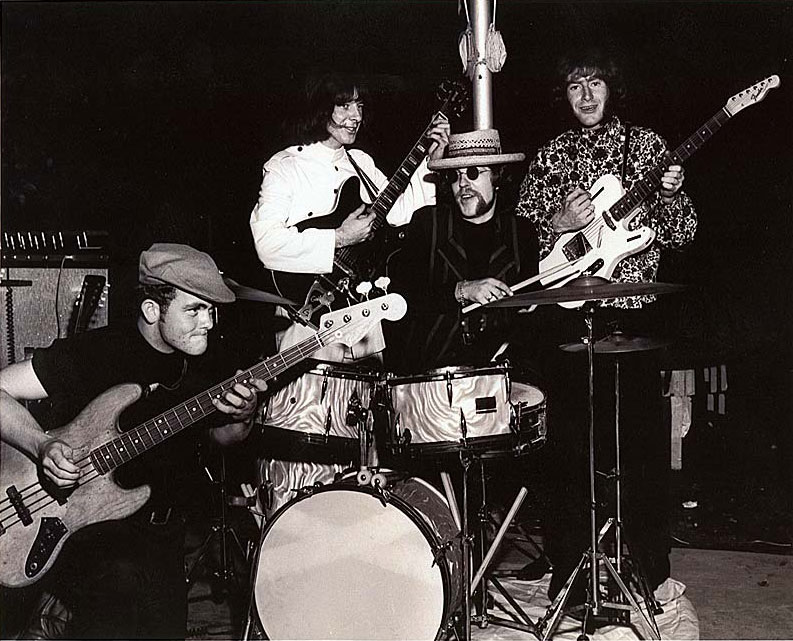
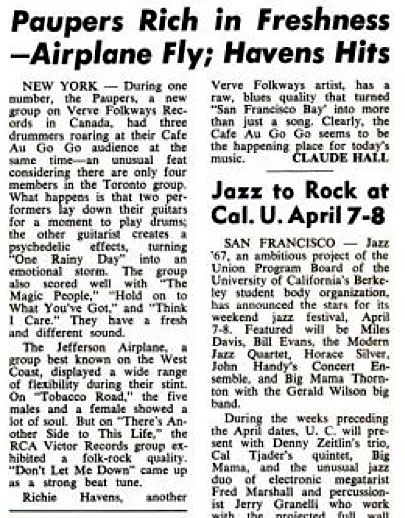
Marion subsequently embarked on a brief solo career, recording a lone single, “Flower Girl” for the Nimbus label in 1967. He then hooked up with The Last Words for a few months before forming the music production company, Cranberry Roadhouse Productions. In 1969, he reverted to his former name, Bill Misener and became a staff producer and manager for RCA’s Sun Bar Productions, later writing for and producing the Quebec group, The Morse Code Transmission. Resuming a solo career in the early ‘70s, he recorded a string of albums for the Grit, CTL and Polydor labels, and enjoyed a sizeable national hit in January 1972 with the single “Little O’l Rock ‘N’ Roll Band”. He subsequently became a successful jingle writer and sang on TV commercials.
Marion’s departure scuttled the Arc deal, but Finkelstein simply walked across the road to the Mousehole folk club and asked singer/songwriter and guitarist Adam Mitchell (b. 24 November 1944, Glasgow, Scotland) to join. The young Scotsman, who’d moved to Toronto at the age of 12, would prove to be the catalyst in raising The Paupers’ profile. Not only did he forge a prolific song-writing partnership with Prokop, but he was also blessed with a distinctive voice.
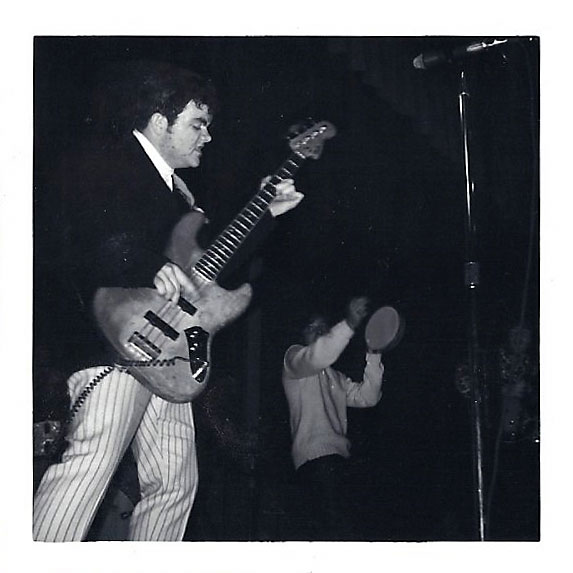
With Mitchell on board, The Paupers embarked on mammoth rehearsals at the Hawk’s Nest, practising for no less than 13 hours a day! Following Ronnie Hawkins’ example with The Hawks (later The Band), Prokop adopted a taskmaster role and “cracked the whip” during rehearsals while Finkelstein charged band members for infractions. The strict regime had an immediate effect as The Paupers quickly developed a tight stage act. “When we came out,” says Prokop, “the group was completely changed. We had a lot of funky, good-time material.”
Debuting at the Broom and Stone in Scarborough (most likely on 14 August), The Paupers were an instant success, and the following month landed an important slot at the highly publicised 14-hour pop show, sponsored by CHUM radio, and held at Toronto’s Maple Leaf Gardens alongside 14 top local bands.
Over the next few months, the group became one of the biggest draws in Yorkville village, performing at notable venues like the Night Owl, the Hawk’s Nest and Boris’ Red Gas Room. By this stage, the band had developed a captivating stage show, which according to Nicholas Jennings, was “built around earth-shaking drums, a wailing guitar and Denny Gerrard’s mind-boggling bass.”
Gerrard was indeed fast becoming a local legend. Donning his trade-mark Sluggo cap, the inspirational musician would later be voted best bass player two years in a row by US critic Ralph Gleason in Playboy magazine’s annual jazz poll. Beal’s guitar playing was also enthralling, as Nicholas Jennings notes, “it was like an early version of U2’s Edge, full of repeating, tape-looped notes and weird effects.” Overnight, The Paupers had become big fish in a small pond. The more lucrative American market beckoned.
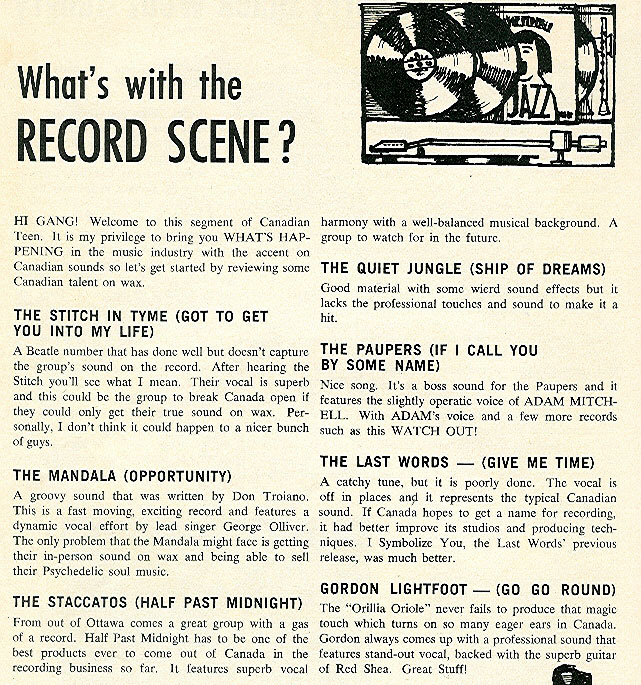
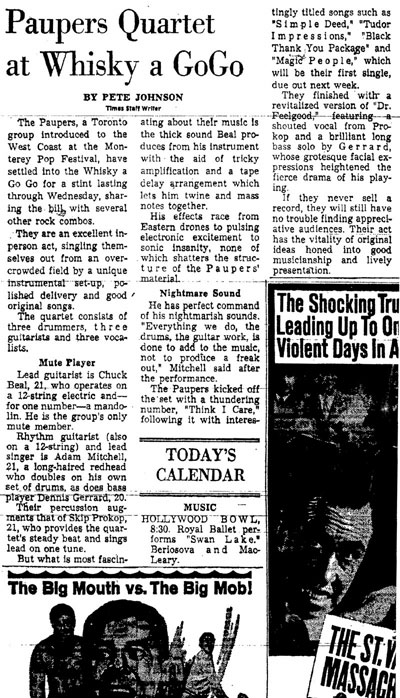
Armed with a four-song demo, Finkelstein flew to the Big Apple early in the new year and to his surprise, MGM agreed to sign the band to its subsidiary, Verve Forecast; a first for a Canadian band. Buoyed by the response, Finkelstein headed over to Greenwich Village and looked up Howard Soloman, the owner of the Café Au Go Go, who offered the band a gig opening for Jefferson Airplane in early March. Finkelstein accepted the booking and headed back to Toronto where The Paupers were riding high with “If I Call You By Some Name”, the group’s debut single with Mitchell. Having peaked at #6 on the CHUM chart on 16 January, the single eventually sold around 35,000 copies.
The stage was set for the group’s debut US appearance at the Café Au Go Go. As those witnessing concur, from the opening bars of “Think I Care”, The Paupers were in their element. By the time they were done, the place was theirs, and critics were not slow in showering the band with praise. Writing in the Village Voice, Richard Goldstein exclaimed: “They have a power and a discipline I’ve never seen before in a performance.”
Following the show, Albert Grossman came back stage to visit the band. As Prokop told The Canadian, “We saw this cat with long, white hair down to his shoulders and Ben Franklin glasses and we didn’t know who he was. About four days later, he approached Bernie and we had a meeting and signed contracts.”
Finkelstein, who had been made a lucrative offer to co-manage the band, subsequently sold his rights to the group for $20,000 and used the money to set up his next project, the experimental folk-rock outfit, Kensington Market. One of Grossman’s first moves as manager meanwhile was to renegotiate the group’s contract with Verve Forecast, which allegedly had been signed for no front money!
Following the success of the New York show, The Paupers released a new single, the bluesy “Simple Deed”, and while it didn’t quite sell as much as its predecessor, still managed to climb to a respectable #23 on the CHUM chart on 27 March.
The group then returned to New York to cut its debut album with producer Rick Shorter. During this time, band members also found time to moonlight on other projects, most notably on Peter, Paul and Mary single “I Dig Rock And Roll”.
With the album in the can, The Paupers flew to San Francisco in early May to play three sets of shows at the Fillmore Auditorium. Opening twice for local acidheads, The Grateful Dead and concluding with a support slot for soul sisters, Martha & The Vandellas, The Paupers’ breezy folk-rock and sunny melodies went over well with the San Francisco audiences.
That same month, Verve Forecast issued a new single, “One Rainy Day”, which apparently sold so poorly that the group pulled it out of the marketplace themselves. Despite the chart failure, the positive reception to the band’s live shows on the West Coast bode well for the up and coming Monterey festival and anticipation was running high.
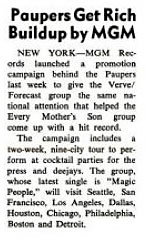
Introduced by Byrds guitarist David Crosby, who hyped the band to the 30,000-strong crowd, The Paupers duly took to the stage on the evening of 16 June, and immediately ran into problems. According to some sources, Gerrard had dropped some acid before the show, which may account for why his bass playing seemed out of sync with the rest of the group. Technical problems also afflicted the group as Beal’s amp crackled on and off. Ralph Gleason, who had championed Gerrard in Playboy earlier in the year, later said that the band was one of the festival’s real disappointments.
Beal has his own take on events. “The tightness of the band was not only one of our strong points, but turned out to be our undoing at Monterey,” he explains. “That night when things went wrong, rather than stop playing, regroup and chat with the audience till things got fixed, we just damned the torpedoes and kept going full speed ahead. As a result, we wound up sinking our own ship. That performance at Monterey, although we didn’t realise it at the time, was the beginning of the end.”
Despite the setback, The Paupers’ live shows continued to attract positive reviews. Writing about a gig at West Hollywood’s Whisky-A-Go-Go in July, journalist Bill Kerby reported in the L.A Free Press: “It is joyfully unnerving to see a group bound together by other than mutual regard for dope, stardom, pedestrian ideas of musical mediocrity, and vague dreams of overnight billions.”
Following Monterey, the group had been sent on a $40,000 promotional tour covering 40 cities, and taking in venues like the Grande Ballroom in Detroit, the Boston Tea Party and the Café Au Go Go in New York. At the last venue in late September, it was the turn of The Paupers to be upstaged, on this occasion by visiting British dignitaries Cream.
Despite the tight touring schedule, The Paupers still found time to “live it up” on the road. Speaking to Ritchie Yorke, Prokop remembers one particularly memorable incident in Las Vegas. “Denny Gerrard made $3,500 on the poker machines, but the next day he lost it all, and his shirt as well. Really, he arrived back at the hotel one morning with no shirt on.” Apparently, the bass player had walked two miles from a casino because he’d lost all his money!
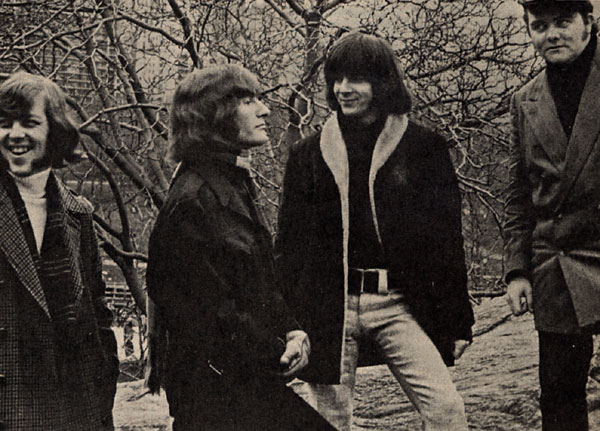
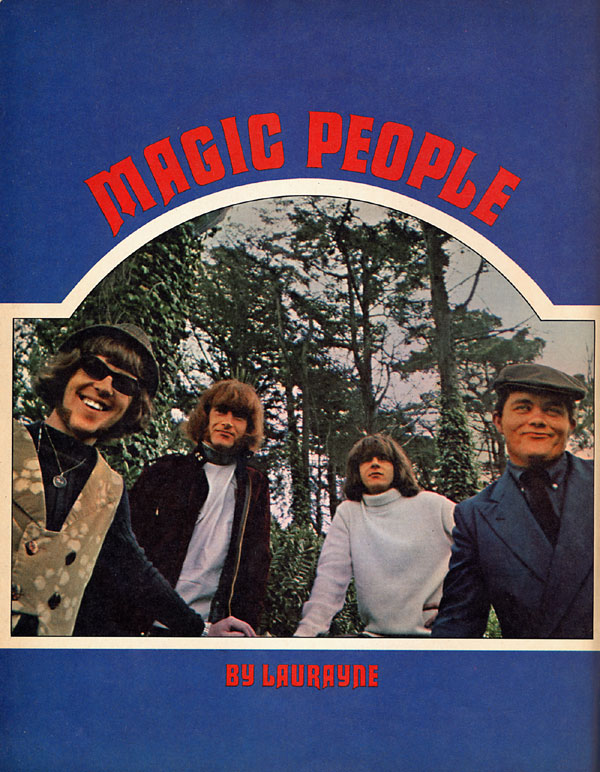
If the group’s declining fortunes weren’t enough to worry about, Gerrard’s behaviour was becoming increasingly more erratic as his consumption of psychedelic drugs reached crisis point.
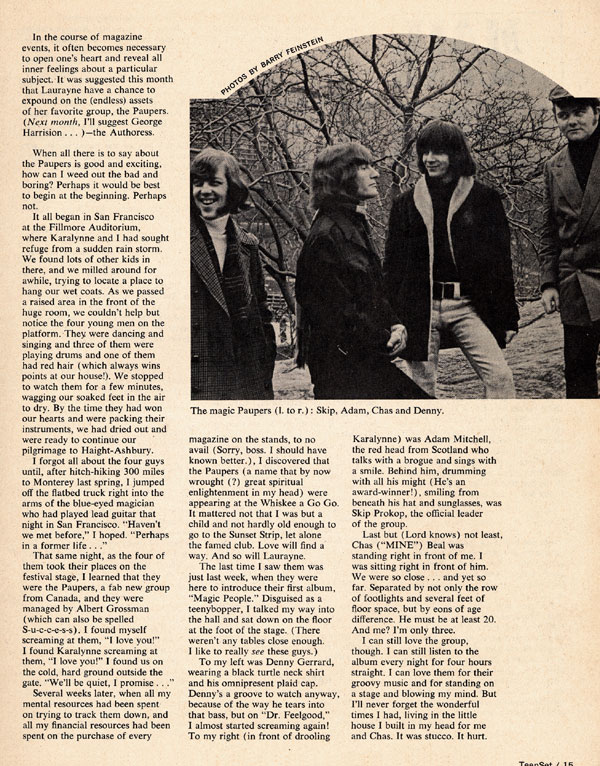
Adam Mitchell remembers a number of amusing incidents during this period, including a rehearsal at the Night Owl club on Avenue Road in Toronto. “We had just been given the first cordless remote for guitar and we had Denny try it on his bass. In the interest of seeing how far away from the amp you could get and still have signal strength, we had Denny walk to the front of the club and then eventually outside. After he’d been outside a while, the signal faded as expected. So did Denny! We went outside and of course there was no sign of him anywhere. We abandoned the rehearsal and spread out in different directions looking for him. As I was heading south on Avenue Road, a rather perplexed fan approached me. ‘Man…I just saw Denny walking down the street playing his bass!’ Never did find him that day or several days after. Such was life with Denny.”
Another incident took place following the group’s performance at the Trauma club in Philadelphia. “Denny never made the plane,” remembers Mitchell. “Several days later I got a call at my place on Hazelton Avenue in Yorkville. ‘Adam, it’s Denny…where am I?’ After having him look out the window and read a few licence plates, we determined he was probably still in Philadelphia. How or when he eventually made it back to Toronto, I don’t remember.”
The Trauma gig also has an interesting side note, says Mitchell. “Two young kids brought a Les Paul for me to autograph, then ran beside the car practically all the way back to the hotel, where they permanently encamped in the lobby. Fast forward to 1988 – Gene Simmons, his girlfriend Shannon Tweed and I had been out for dinner in LA and had to stop off at a film distributors’ conference on the way home so that Shannon could make an appearance. As we entered the room, some guy started yelling, ‘Adam, Adam!’ I had no idea who he was until he introduced himself and told me he was one of those two young kids in Philadelphia. His name was Frank Stallone. The other kid was his brother, Sylvester Stallone.”
By early 1968, the group had lost patience with Gerrard’s behaviour and reluctantly asked him to leave. However, as Beal admitted to Nicholas Jennings, the group was a lesser force without their inspired bass player. “Denny did for the bass what Hendrix was doing for the guitar. Nobody had seen anything like this.” Mitchell agrees. “He was absolutely brilliant as a player. His bass solo, I believe was the most electrifying thing in music I’ve ever seen.”
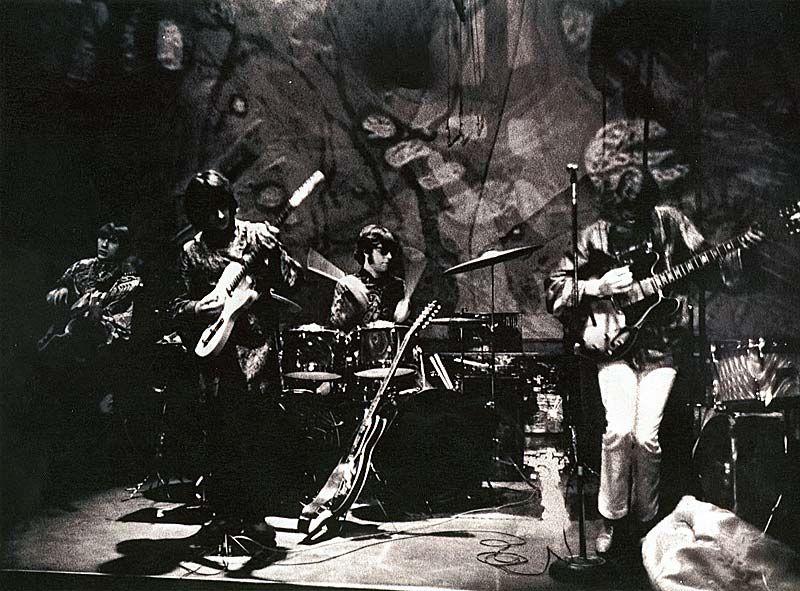

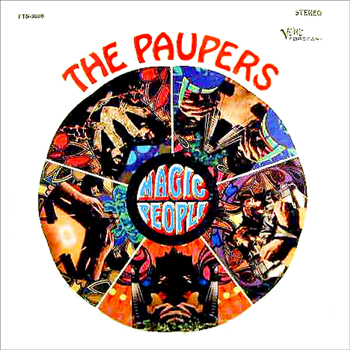
Amid all this activity, the band’s debut album Magic People, which had been released back in June just prior to the Monterey festival, had slowly crept up the Billboard charts and finally peaked at a rather disappointing #178. Despite the poor placing, the album has some strong moments, most notably in its kaleidoscopic drum-driving title track. Other highlights include the infectious folk-rocker “You and Me”, the haunting “My Love Hides Your View” and the angst-ridden “Think I Care”, generally considered to be The Paupers’ definitive song. The track was lifted as a single in early 1968, but flopped.
While The Paupers failed to make any headway in the charts, they continued to live up to their reputation as a live act. On 24 February, the group returned to Toronto and played a memorable set at the Canadian National Exhibition supporting The Jimi Hendrix Experience and The Soft Machine.
Nevertheless, the pressures of travelling on a tight budget were beginning to take its toll, with each man reduced to living off $2. First to crack was newcomer Peter Sterbach who dropped out sometime in early 1968. Skip Prokop, who also entertained thoughts of leaving the band during this period, apparently changed his mind when the label agreed to do a second album.
Taking time off the road, the group stopped in Nashville to record three tracks – “All About Me”, “Words I Say” and “See Yourself” but according to Beal the sessions did not go well and the recordings were shelved. Despite the failure to complete any tracks towards a new album, Beal says the Nashville trip did have its perks. “For me the highlights included meeting Tex Ritter, listening to Flatt and Scruggs record, watching one of the Jordinaires get so rapped up in a game of ping pong, he forgot that he left his car with the engine running and it ran out of gas, and above all having Floyd Cramer play on our session. It was nuts, we just called his answering service and within 15 minutes, he was there.”

Travelling to New York in early May, the group’s new producer Elliot Mazer hooked The Paupers up with keyboard player Al Kooper, who had recently been ousted from his group, Blood, Sweat & Tears. Turning his creative energies to The Paupers, Kooper’s contributions complement the group’s performances brilliantly and the resulting album, Ellis Island, recorded at Columbia Studios over several months, remains a hidden gem of late ’60s rock.
Lacking the consistency of the group’s debut outing, the record’s strength lies in its individual tracks. These range from extended hard-rock workouts like “South Down Road” and “Numbers” (featuring Brad Campbell on lead vocal), to more reflective pieces such as Prokop’s “Oh That She Might”, with a rare vocal outing from the drummer. Adam Mitchell emerges as the dominant writing force and his “Cairo Hotel”, apparently written about a hotel in Washington DC where most of the tenants were down and outs, is particularly poignant.
Another noticeable difference on the album, compared to his predecessor, is the group’s experimentation with exotic sounds – one particular track, “Ask Her Again”, features Prokop on the koto, a Japanese stringed instrument (a present given to the drummer by Peter, Paul & Mary after a Japanese tour).
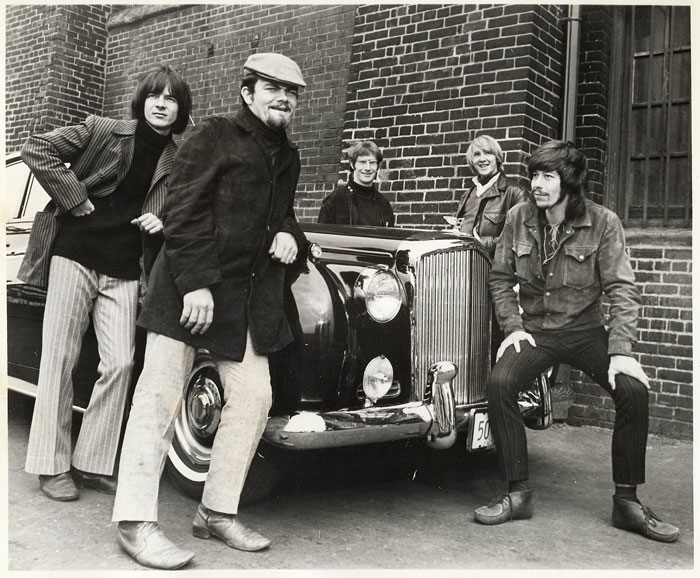
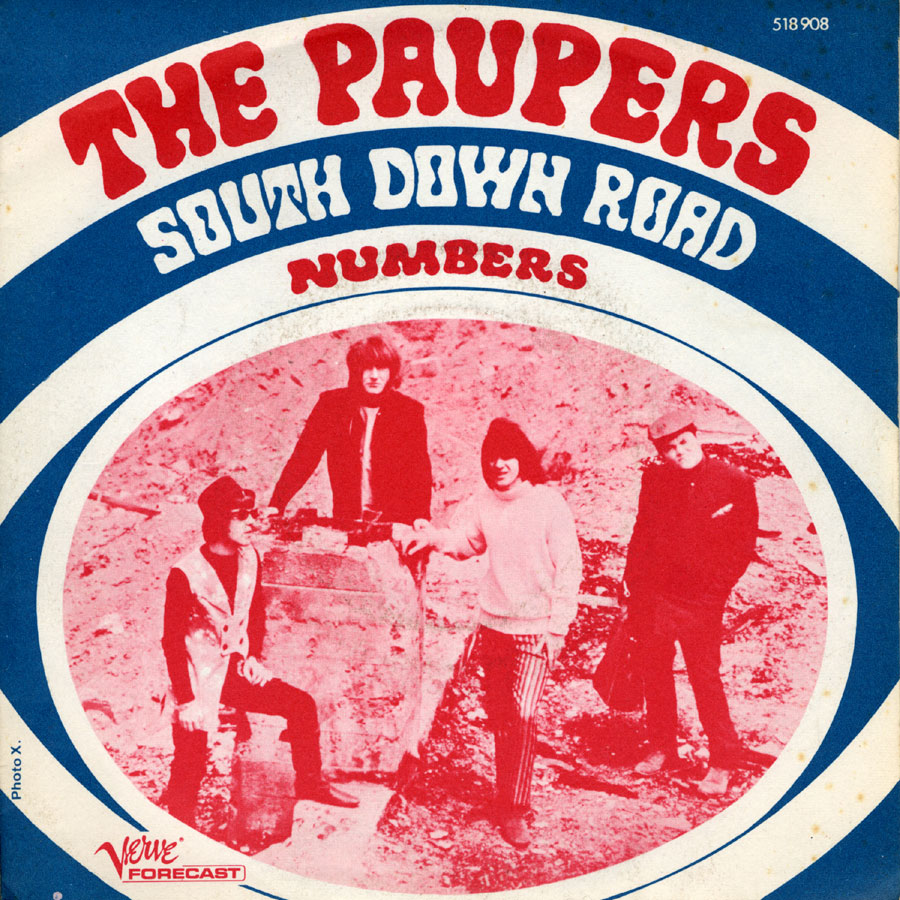
With the album in the can, the band realised that it needed to reproduce Kooper’s keyboard parts in a live format, and duly recruited former Fraser Loveman Group member Jonn (aka John) Ord (b. 3 April 1945, London, England) during late July. As Ord recalls, “I had a little trio called The Nuclear Tricycle that was playing in a bar on Yonge Street. It was a summer job for me and I was at university. Skip heard about me and came in to see me. I went out to Brad Campbell’s house in Oakville to meet the band and they played me the album. I was able to play off the keyboard parts pretty fast and they thought it would be a good fit.”
The quintet quickly reconvened to Ord’s parents’ farm in Fenwick, in the Niagara peninsula. Rehearsing intensively for a week in a nearby farmhouse, the new Paupers line-up soon launched in to a small tour. The band’s debut show at the Grande Ballroom in Detroit on 2-4 August proved memorable, not least because the club still had bullet holes in it from the race riots earlier in the year.
During this period, some of the band members flew to New York between dates to do studio work. Ord, who was involved in the session work alongside Campbell and Prokop remembers working with Richie Havens on his album Richard P Havens, 1983, and also providing support for a female singer called Leonda. The sessions, as Ord points out, appear to have soured relations between band members and ultimately may have sown the seeds that led to the group’s collapse the following month. “I found out that the band was in a state of conflict and frustration, perhaps partially because some musicians were recording and the others were stuck on the road. In the end, the band broke up and everyone went home to Toronto.”
Things had come to ahead when Prokop announced his decision to leave the band after The Paupers’ engagement at the Electric Circus in New York, which ran from 29 August to 1 September. Although he would subsequently form his own outfit, the big band Lighthouse, Prokop nearly joined Janis Joplin’s new group, soon to become better known as The Kozmic Blues Band, but declined her offer.
The offer had been made during the Richie Havens sessions as Ord recalls. “Janis dropped into the sessions and we had some jams with her. Our mutual manager Albert Grossman was looking for musicians for her new band from among his own musicians. Harvey Brooks from The Electric Flag came in with her at one point and he was also looking for musicians for her.”
Prokop confirms that a number of tracks, including a version of “Hey Joe”, and some Aretha Franklin covers were recorded in the studio with Joplin and have yet to see the light of day. Joplin’s insistence on retaining Sam Andrews from Big Brother & The Holding Company for her new band project however, ultimately led Prokop to back out. Following an appearance on Al Kooper and Mike Bloomfield’s Live Adventures album and supporting Mama Cass at Caesar’s Palace in Las Vegas, Prokop pieced together Lighthouse.
Brad Campbell meanwhile landed on his feet. After briefly gigging with the Pozo Seco Singers, he took up the offer from Janis Joplin. He would remain with the troubled singer until her untimely death, appearing in both The Kozmic Blues Band, and its successor, the Canadian-dominated Full Tilt Boogie Band. According to Pete Frame, he would often work under the pseudonym Keith Cherry. Campbell currently lives in Milton, Ontario and plays with a reformed Last Words.
With Prokop and Campbell out of the picture but with debts of $40,000, the remaining members decided to carry on. “I recall advocating that we reform The Paupers in Toronto as the band was well known and we could probably do well with a change of members,” says Ord. The Paupers quickly recruited local drummer Roz Parks (b. 15 April 1945, Picton, Ontario) from The Creeps and Magic Circus fame and perhaps more importantly, in terms of credibility, brought original bass player Denny Gerrard back in to the fold. Though Gerrard had spent most of 1968 recovering from his drug exploits, he had recently returned to studio and live work with Toronto’s highly rated blues combo, McKenna Mendelson and was in fighting form.
The group soon returned to the local club scene, debuting at the Night Owl on 26-27 October. Journalist Ritchie Yorke writing that November in the local RPM magazine, reviewed the show and captured perfectly the new line-up’s potential. “They emerged as a tight, cohesive musical unit, devoid of pseudo-hippiness and brimming over with confidence.”
True the group may have found a new confidence, but this was soon shattered by Gerrard’s inability to keep on the straight and narrow. As Ord recalls, “we did well for a while getting quite a bit of work and playing a lot. Then Denny started to lose it again…missing rehearsals and eventually not showing up for an important concert. The other band members said they had been through this already and that nothing worked. Roz and I were very fond of Denny and tried everything to make things work, but in the end we had to fire him and found a new bass player.”
As Jonn Ord notes, Gerrard’s departure proved a catalyst for Mitchell’s own exit from the group in April 1969. “Adam became discouraged and decided to leave also, so we replaced him with James Houston who had worked with Roz in The Magic Circus.”
Adam Mitchell subsequently embarked on a brief solo career, before moving into production work for the likes of McKenna Mendelson Mainline and McKendree Spring (who covered his song “Cairo Hotel”). In 1970, he became Linda Ronstadt’s musical director, the fruits of which turned up on Silk Purse. Mitchell also emerged as a successful songwriter, and during the ‘70s and ‘80s saw his compositions covered by John Waite, Olivia Newton-John, Art Garfunkel and Kiss to name a few. A long-awaited solo album, Red Head In Trouble, finally appeared in 1979. Mitchell currently lives in San Miguel de Allende, Mexico and Santa Monica, California and continues to produce, write and perform in the US and Canada.
The Paupers ploughed on with new members James Houston (b. 25 May 1946, Belfast, Northern Ireland) and Mel O’Brien (who had previously played with The Proverbs, The Five D and The Five Shy) but, despite some notable shows at the Night Owl during August 1969, soon ran out of steam as Beal recalls.
“James was a member of The Creeps and a friend of Roz Parks. He was a pretty good singer/songwriter… The bass player was Mel O’Brien [who] was really talented but a bit of a loose canon. We did a bunch of local dates with Mel but it was clear that the band was going nowhere real fast. We knew we needed a record deal and booked some time into the RCA studios in Toronto to do some demos of Jaime’s tunes. Mel didn’t show up for the session and that was it for him. After that none of us had the energy or the desire to start over again so, we packed it in. A sorry end to what was once a pretty good band.”
From the ashes of the group, James Houston (who now goes by the name John Peel) formed his own group, Houston, which issued a lone single “Sally Bumper” and eponymous album for Tuesday Records during 1970.
Jonn Ord, whose band backed Chuck Berry at Toronto’s Electric Circus in the summer of 1969, later acquired a music degree from York University and currently plays in Ontario’s Georgian Bay area.
Roz Parks meanwhile worked with Edward Bear and Tranquillity Base (where he was joined by Houston) among others before changing his name to Ron. A few years ago, he issued his debut solo album Golden Rocket.
While The Paupers’ potential was never fully realised, the degree of talent within the band can be gleaned from the band’s best work, and the subsequent achievements of group’s members, Brad Campbell, Adam Mitchell and Skip Prokop.
Following a successful career with Lighthouse, Prokop leant his talents to a diverse range of projects, including working with street kids, running an advertising agency and doing jingles. Like Mitchell, he also issued a solo album, All Growed Up, in 1979 and in recent years has played in a reformed Lighthouse. Living in London, Ontario, he is currently writing his autobiography.
Denny Gerrard continued to make sporadic appearances on record throughout the late ‘60s and ’70s, most notably on Jericho’s superb eponymous album for Bearsville Records in 1971, and in his work with Rick James’s pre-Motown bands, Heaven and Earth and Great White Cane. Still revered by his contemporaries, Gerrard remains a local legend. In 1997, after years of inactivity, he made a rare appearance on record, playing with Mike McKenna’s blues band Slidewinder.
Chuck Beal briefly worked as a music producer, promoter and manager for Canadian bands. Later he worked at the Canadian National Institute For The Blind, producing the talking books series and also did some writing and research for CBC radio in Toronto. He is currently a computer consultant and has his own website.
Looking back, Mitchell is philosophical about the band’s premature demise. “As incredible as the band truly was, we were victims of just plain bad luck,” he says. “Bad luck, not only that Denny did too many drugs at Monterey and Chuck had a bad guitar chord. But perhaps more importantly, bad luck that we had the wrong record producer, the wrong studio and the wrong label. We were young, the business was new and we didn’t know any better.”
Magic People and Ellis Island are now available for the first time on CD from Pacemaker Records. Each release includes bonus tracks.
Advertised gigs
April 25 1965 – Maple Leaf Gardens with Rolling Stones, Jon and Lee & The Checkmates and others
July 29 1965 – “Red Cross Blood Donor Clinic”, Varsity Arena, Toronto with Jon and Lee & The Checkmates, The Big Town Boys and J B & The Playboys
August 26 1965 – Canadian National Exhibition, under 21 club, Toronto with David Clayton-Thomas & The Shays
December 3-4 1965 – El Patio, Toronto
December 11 1965 – Gogue Inn, Toronto
January 28 1966 – Gogue Inn, Toronto with Dunc & The Deacons, The Lively Set with Dean Curtis
February 4 1966 – Jubilee Auditorium, Oshawa, Ontario
February 18 1966 – Gogue Inn, Toronto with Jack Hardin & The Silhouettes and The Lively Set
February 24-25 1966 – El Patio, Toronto
March 11 1966 – North Toronto Memorial Arena, Toronto (March 24 advert for new singer)
April 1 1966 – Gogue Inn, Toronto with The Twilights and Dean Curtis & The Lively Set
April 8-9 1966 – El Patio, Toronto
April 15-16 1966 – El Patio, Toronto
April 22 1966 – North Toronto Memorial Arena, Toronto
June 10 1966 – North Toronto Memorial Arena, Toronto
June 20-25 1966 – El Patio, Toronto
July 7-10 1966 – El Patio, Toronto
July 10 1966 – Jubilee Auditorium, Oshawa, Ontario
July 19 1966 – North Toronto Memorial Arena, Toronto with The Shays and Dee & The Yeomen
July 24 1966 – El Patio, Toronto
August 14 1966 – Broom and Stone, Scarborough, Ontario with Little Caesar & The Consults and The Knaves
August 24 1966 – Don Mills Curling, Don Mills, Ontario with The Spasstiks, The Del-Tones and The Fugitives
August 31 1966 – Broom and Stone, Scarborough, Ontario with The Marksmen
September 9 1966 – El Patio, Toronto
September 24 1966 – Maple Leaf Gardens with Luke & The Apostles, The Ugly Ducklings, The Tripp, The Last Words, Bobby Kris & The Imperials, The Stitch In Tyme, The Spasstiks, R K & The Associates, Little Caesar & The Consuls, The Big Town Boys and others
October 2 1966 – Club Kingsway, Toronto with Wilson Pickett and Dee & Lee & The Roulettes
October 10-14 1966 – The Night Owl, Toronto
October 15 1966 – Club 888, Toronto with A Passing Fancy
October 27 1966 – The Night Owl, Toronto
October 29-30 1966 – The Night Owl, Toronto
November 5 1966 – Gogue Inn, Toronto with Associates, The Wyldfyre and others
November 11 1966 – Boris’, Toronto
November 12 1966 – The Hawk’s Nest, Toronto
November 18-20 1966 – Red Gas Room, Toronto
November 27 1966 – Red Gas Room, Toronto
December 3-4 1966 – Red Gas Room, Toronto
December 10 1966 – The Hawk’s Nest, Toronto with Dee & The Yeomen, The Manx, The Evil
December 11 1966 – Maple Leaf Gardens, Toronto with The Lovin’ Spoonful and The Children
December 23 1966- Club 888 Toronto
December 24-27 1966 – Boris’, Toronto with Luke & The Apostles
December 29-1 January 1967 – Boris’, Toronto with Luke & The Apostles
January 22 1967 – Boris’ Red Gas Room, Toronto
February 10 1967 – West Hill Collegiate, Toronto
February 12 1967 – Boris’ Red Gas Room, Toronto with Luke & The Apostles
February 21-March 5 – Café Au Go Go, New York with Jefferson Airplane and Richie Havens (replaced by B B King)
March 11 1967 – Boris’, Toronto with Simon Caine & The Catch (next two may not have happened)
March 12 1967 – Boris’, Toronto with The Ugly Ducklings
March 17 1967 – Wexford Collegiate, Scarborough, Ontario
March 18 1967 – Boris’ Red Gas Room, Toronto
April 28-30 1967-Cafe A Go Go, NY
May 5-6 1967 – Fillmore Auditorium, San Francisco with Grateful Dead
May 12-14 1967 – Fillmore Auditorium, San Francisco with Grateful Dead
May 19-20 1967 – Fillmore Auditorium, San Francisco with Martha & The Vandellas
June 16 1967 – Monterey International Pop Festival, Monterey, California
July 14 1967 – Whisky A Go Go, West Hollywood with The Youngbloods
July 14-19 1967– Whisky Au Go-Go Los Angeles
July 1967 – Whisky A Go Go, West Hollywood with Johnny Rivers.
July 28-29 1967 – Boston Tea Party, Boston with Bagatelle
August 1967 – MGM sends them on a 9 city tour of parties for press and deejays starting in Seattle, San Francisco, Los Angeles, Dallas, Houston, Chicago, Philadelphia, Boston and Detroit.
August 20-26 1967 – Garden of Stars, Montreal with The Munks
August 30 – September 3 1967 – Ambassador Theater, Washington, DC
September 15-17 1967 – The Flick, Toronto
September 18 1967 – Maple Leaf Gardens, Toronto
September 28-October 1 1967 – Café Au Go Go, New York with Cream (cut short due to faulty equipment)
October 20 1967 – Hunter’s College, New York with Jefferson Airplane
November 3-5 1967 – Grande Ballroom, Detroit with MC5
December 8 1967 – Aurora Community Arena, Aurora, Ontario
December 27-30 1967 – The Flick, Toronto
January 12 1968 – York University, Toronto with The Last Words and The Magic Circus
January 27 1968 – North Toronto Memorial Hall, Toronto
February 24 1968 – CNE Coliseum, Toronto with The Jimi Hendrix Experience and The Soft Machine
February 29-March 3 1968 – The Flick, Toronto
March 12-24 1968 – Electric Circus, New York
April 1968 – Ottawa Coliseum with Colleen Peterson, The Eye of Dawn and The Five D
April 2-4 1968 – Kinetic Playground, Chicago
April 17 1968 – Westbury Music Fair, Westbury, New York with Neil Diamond and The Lemon Pipers
May 21-22 1968 – The Night Owl, Toronto
June 15 1968 – Broom and Stone, Scarborough, Ontario with The Dynamics
June 29-30 1968 – The Night Owl, Toronto with The Rockshow of The Yeomen
August 2-4 1968 – Grande Ballroom, Detroit
August 29-September 1 1968 – Electric Circus, New York
October 26-27 1968 – The Night Owl, Toronto with The Rockshow of The Yeomen
October 30 – November 3 1968 – The Night Owl, Toronto with The Rockshow of The Yeomen
November 9-10 1968 – The Night Owl, Toronto
November 16-17 1968 – The Night Owl, Toronto
November 23 1968 – Neil McNeil’s High School, Toronto
December 26-27 1968 – El Patio, Toronto
December 29 1968 – January 1 1969 – El Patio, Toronto
June 29 1969 – The Cove, Gravenshurst, Ontario with The Night People
July 2 1969 – Kingsmen Centre, Oshawa, Ontario
August 7-8 1969 – The Night Owl, Toronto
August 11-15 1969 – The Night Owl, Toronto
Many thanks to Skip Prokop, Adam Mitchell, Chuck Beal, Jonn Ord, Denny Gerrard, Ron Parks, James Houston, Brad Campbell, Bill Munson, Stan Endersby, Nicholas Jennings, Martin Melhuish, Joey Cee, Ritchie Yorke, Peter Goddard and Philip Kamin, Carny Corbett, Bev Davies and Mike Paxman. The Toronto Telegram’s After Four section on Thursdays has also been really handy as a resource for live dates. Thanks to Marc Skobac for additional dates, and to Ivan Amirault for scans from RPM magazine.
Copyright © Nick Warburton, 2003. Updated 2009. All Rights Reserved. No part of this article may be reproduced or transmitted in any from or by any means, without prior permission from the author.
Email: Warchive@aol.com
Visit: www.nickwarburton.com
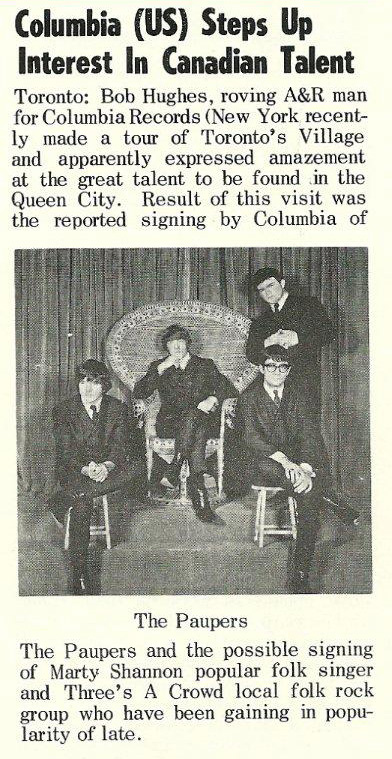
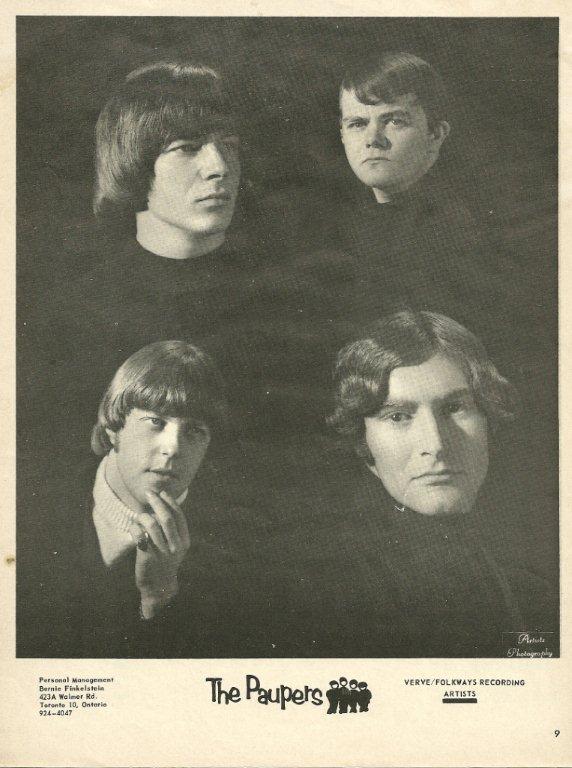
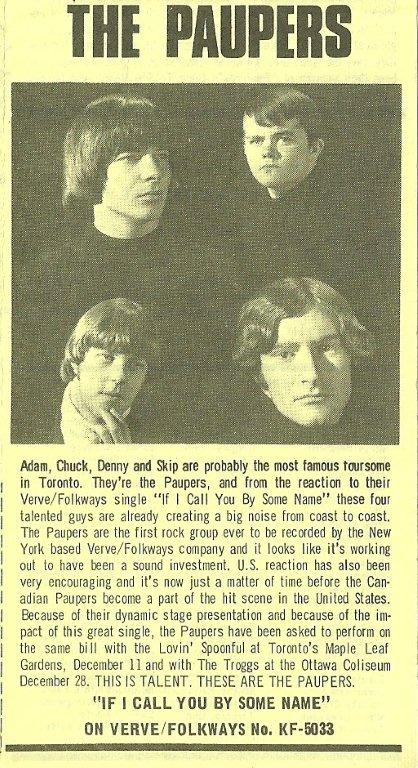
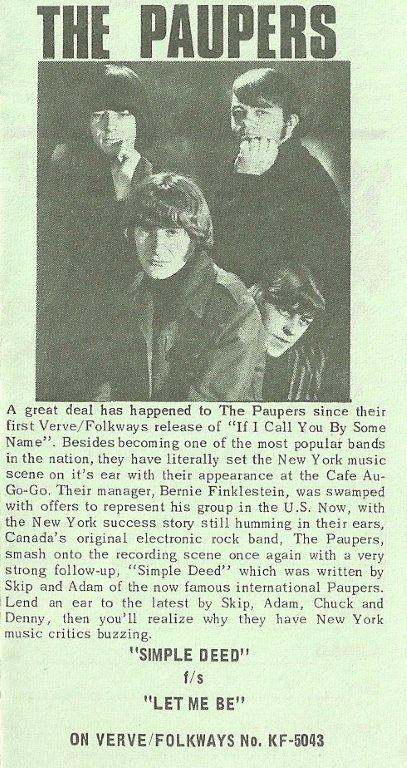
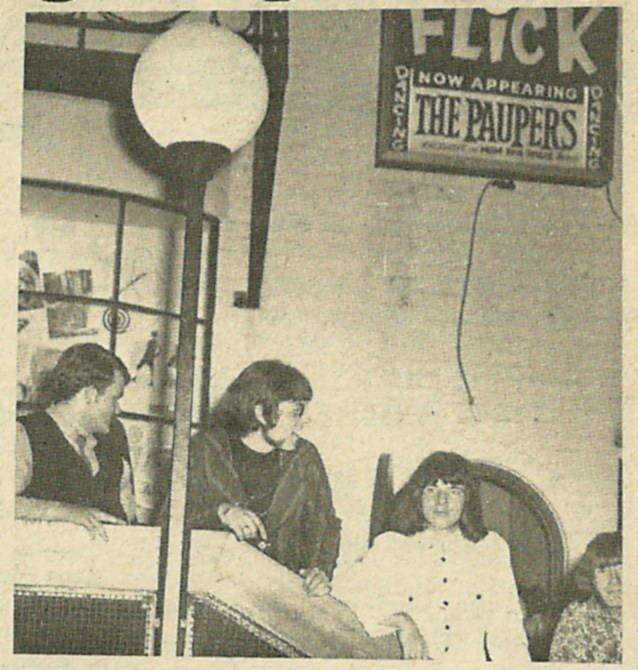

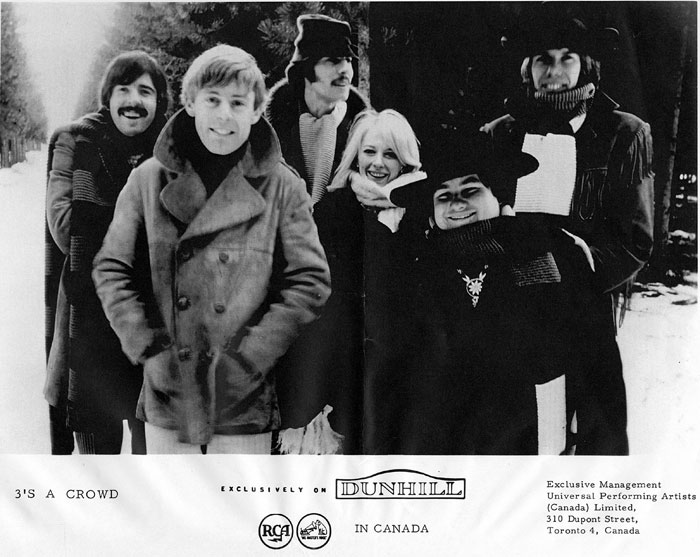
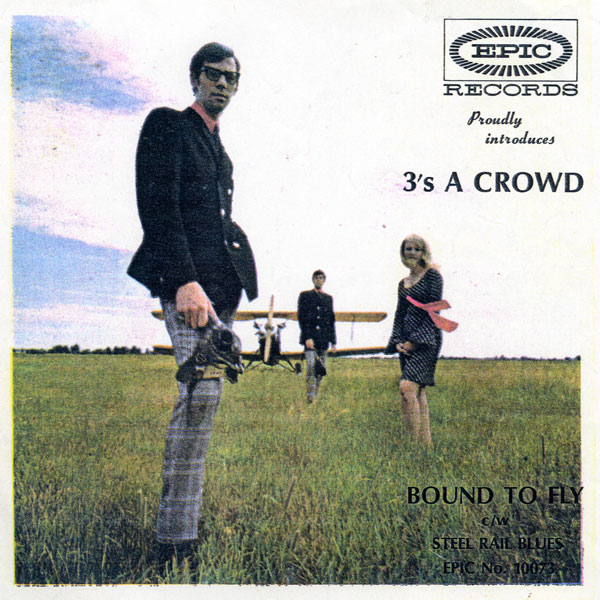
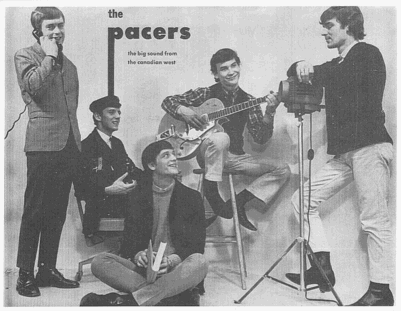
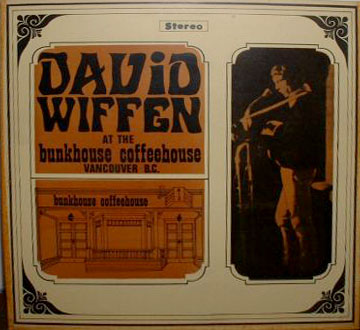


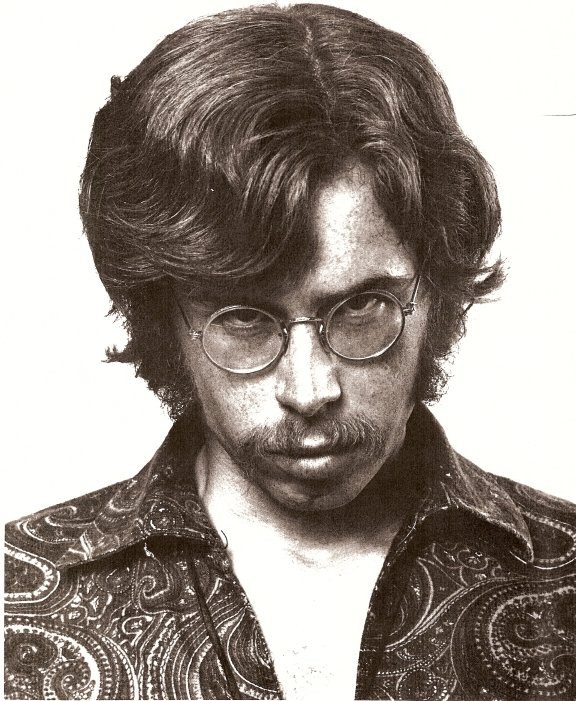
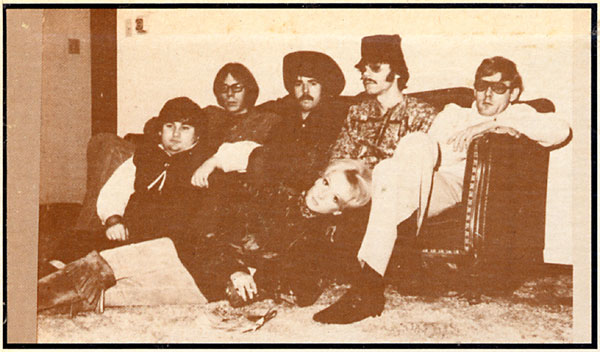
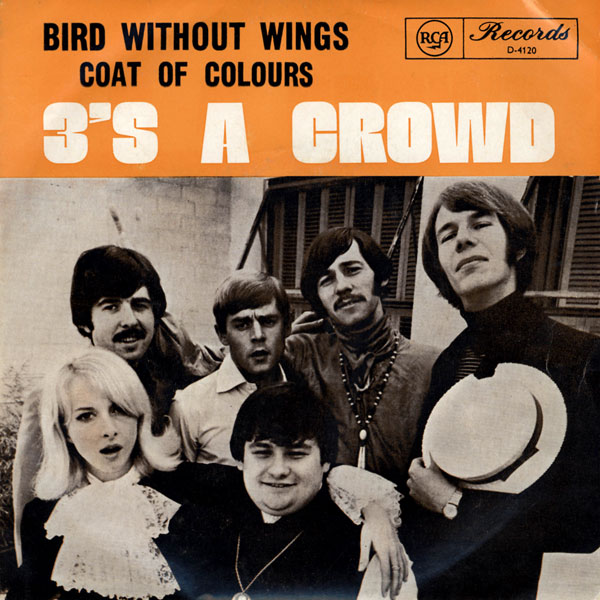
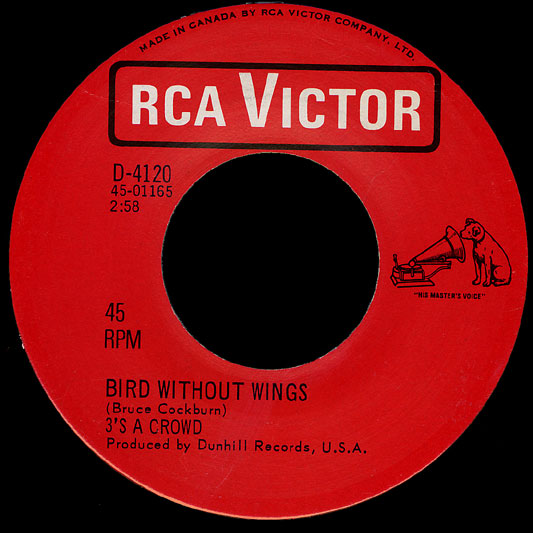
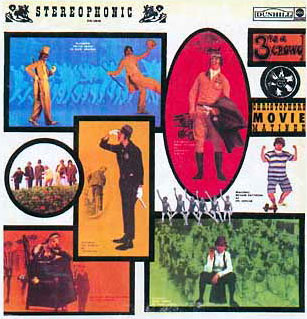
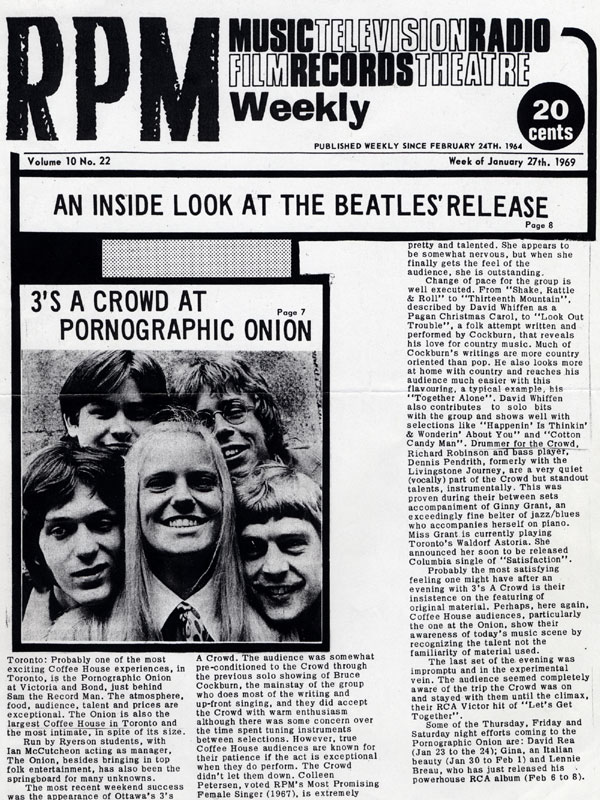
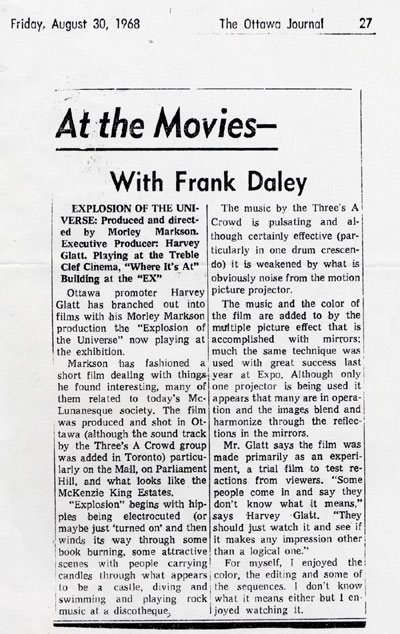
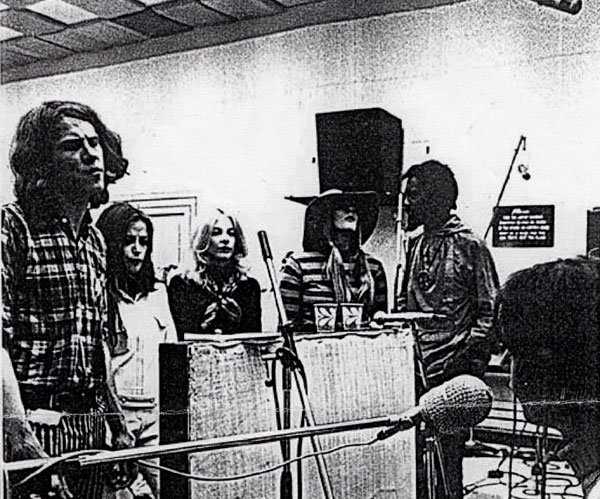
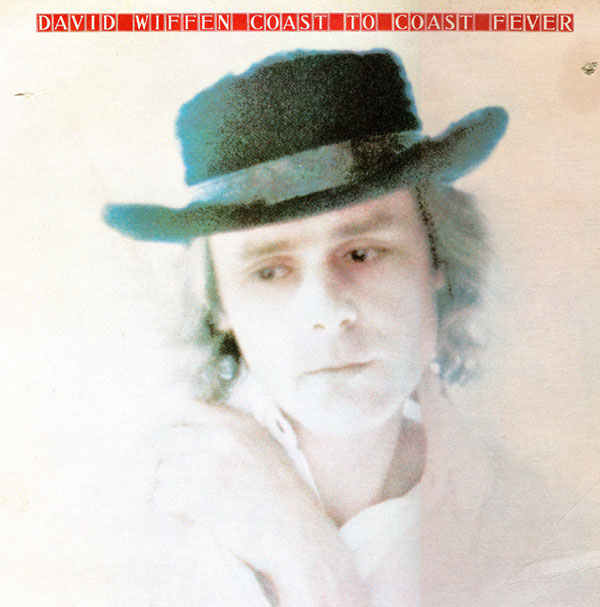
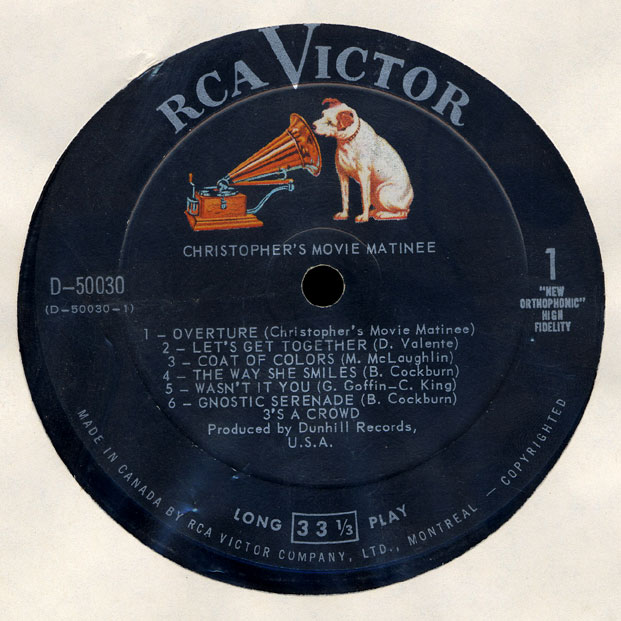
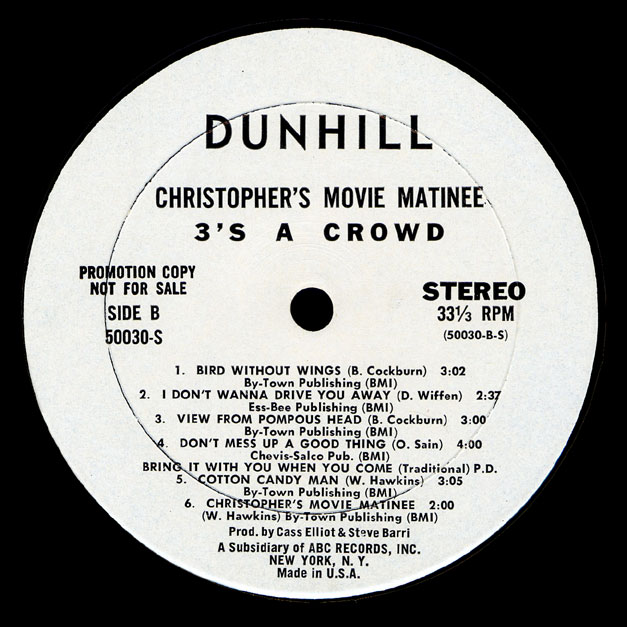
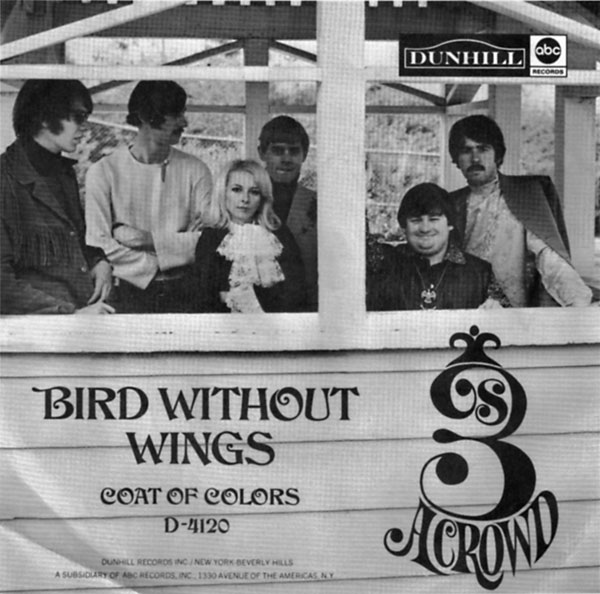
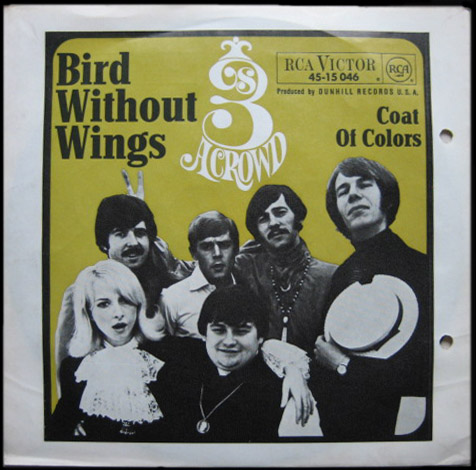
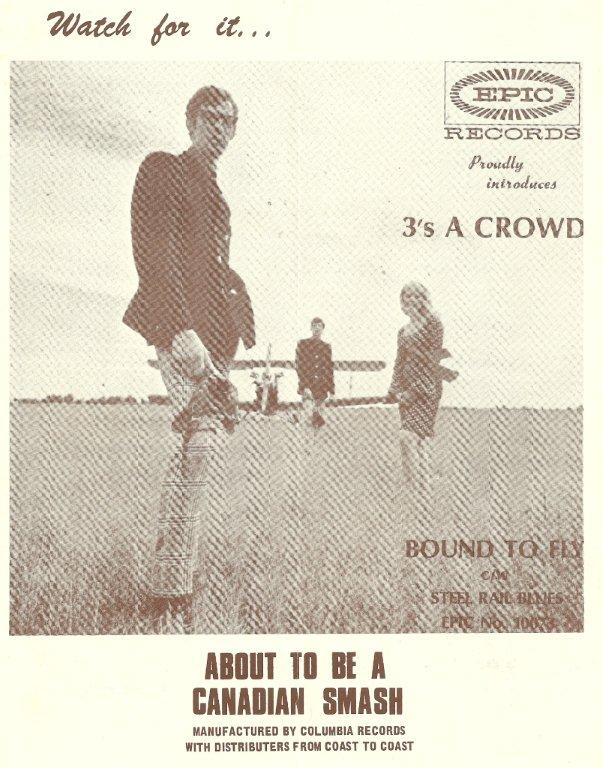
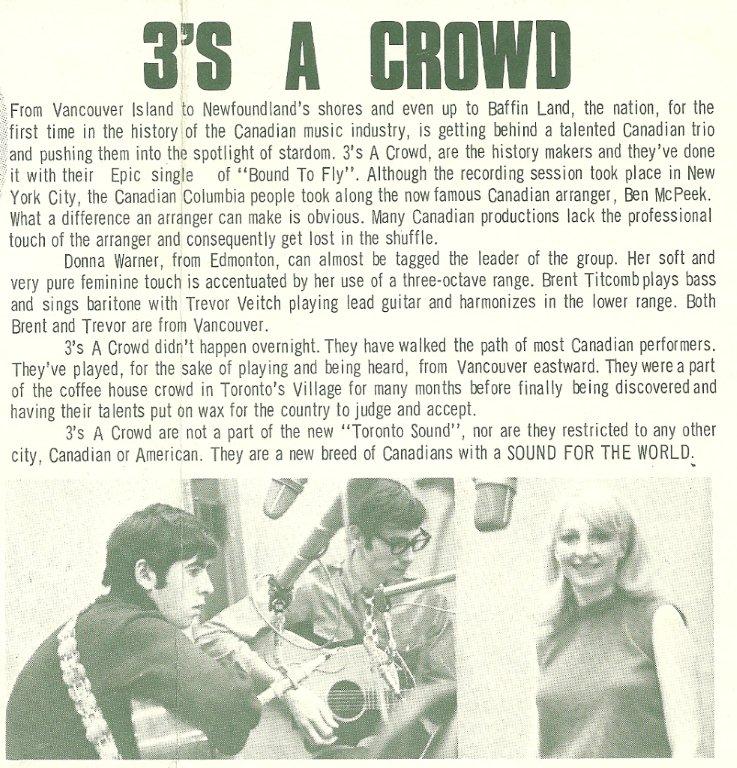
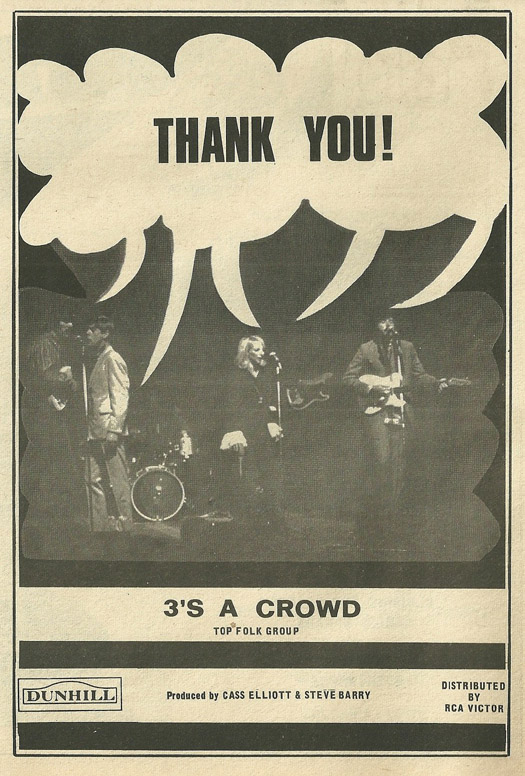
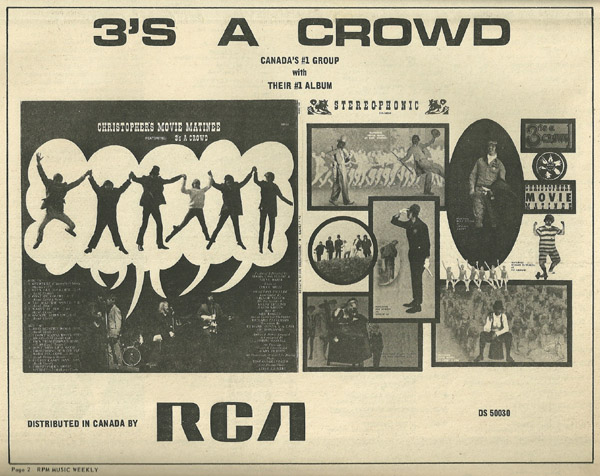
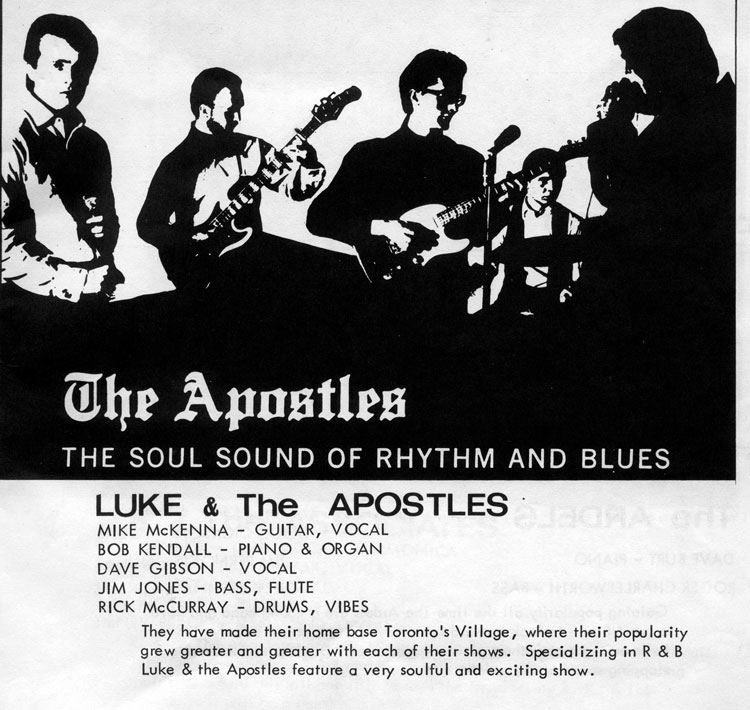


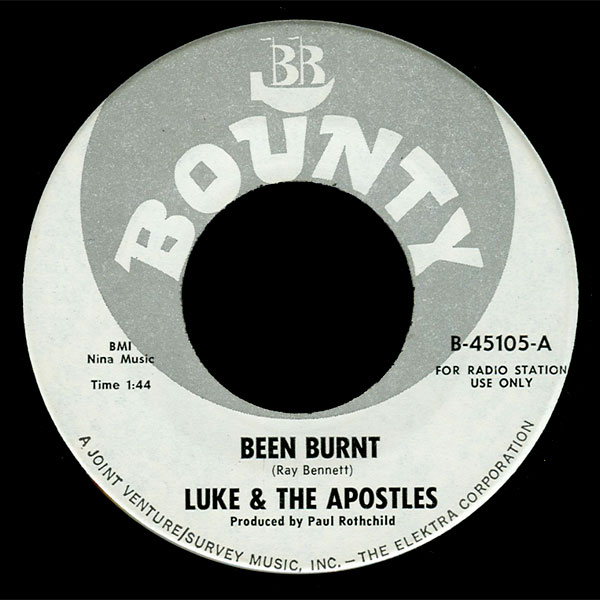
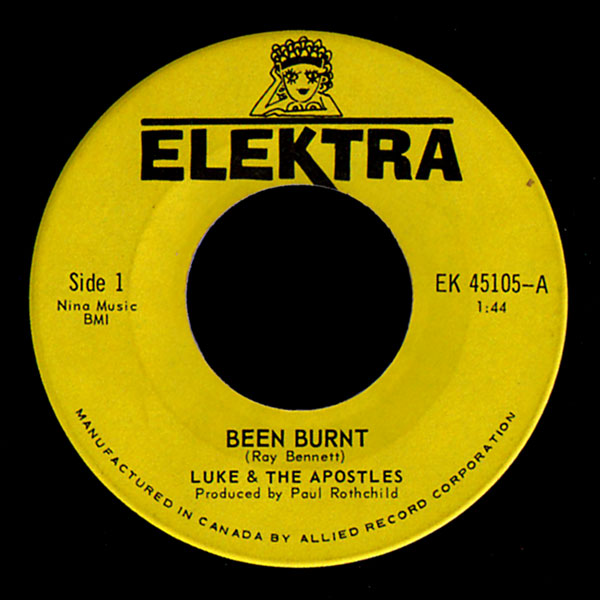 Undeterred, Luke & The Apostles resumed gigging in Toronto and began to extend their fan base beyond Yorkville Village, performing at venues like the North Toronto Memorial Arena on 28 May. But uncertainty over the single’s release and the band’s long-term future began to take its toll, and in early summer Jim Jones announced that he was leaving because he wanted to give up playing. Former Simon Caine & The Catch bass player Dennis Pendrith (b. 13 September 1949, Toronto), who was still in high school at the time, had the unenviable task of filling his idol’s shoes.
Undeterred, Luke & The Apostles resumed gigging in Toronto and began to extend their fan base beyond Yorkville Village, performing at venues like the North Toronto Memorial Arena on 28 May. But uncertainty over the single’s release and the band’s long-term future began to take its toll, and in early summer Jim Jones announced that he was leaving because he wanted to give up playing. Former Simon Caine & The Catch bass player Dennis Pendrith (b. 13 September 1949, Toronto), who was still in high school at the time, had the unenviable task of filling his idol’s shoes.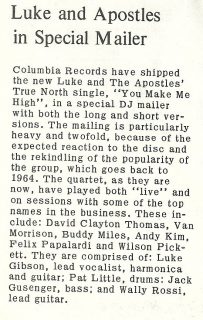
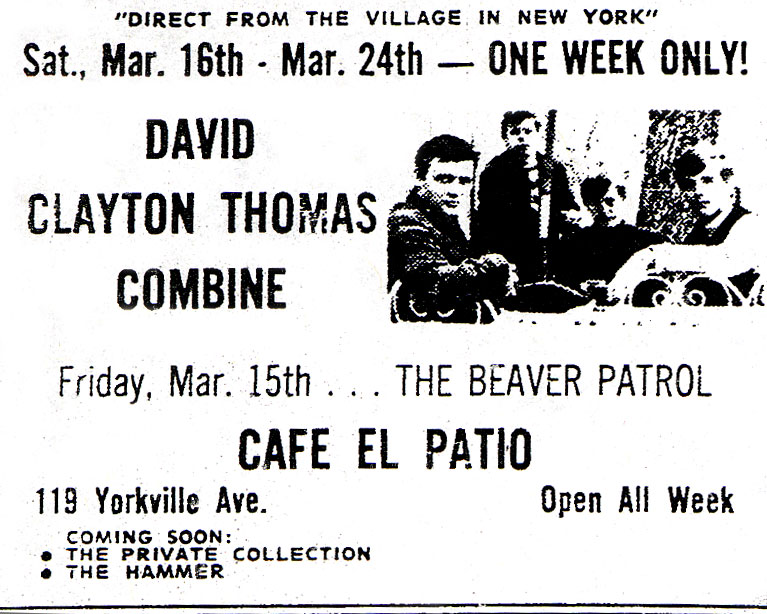
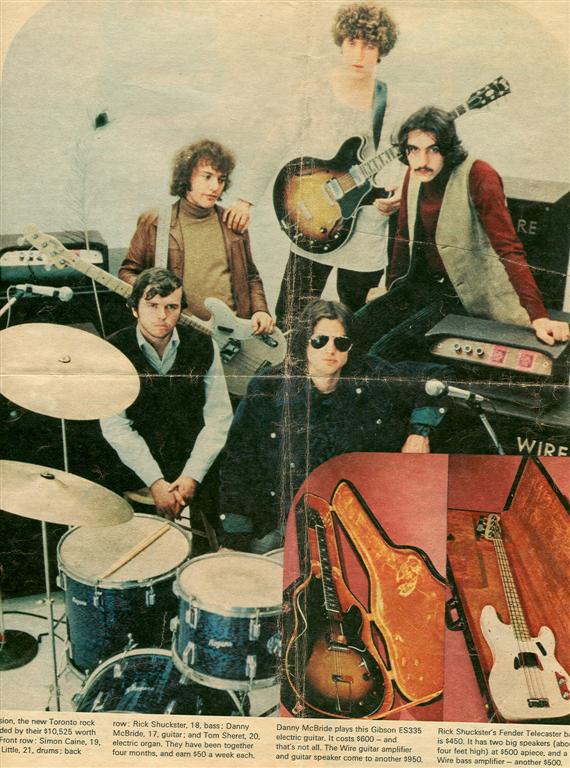
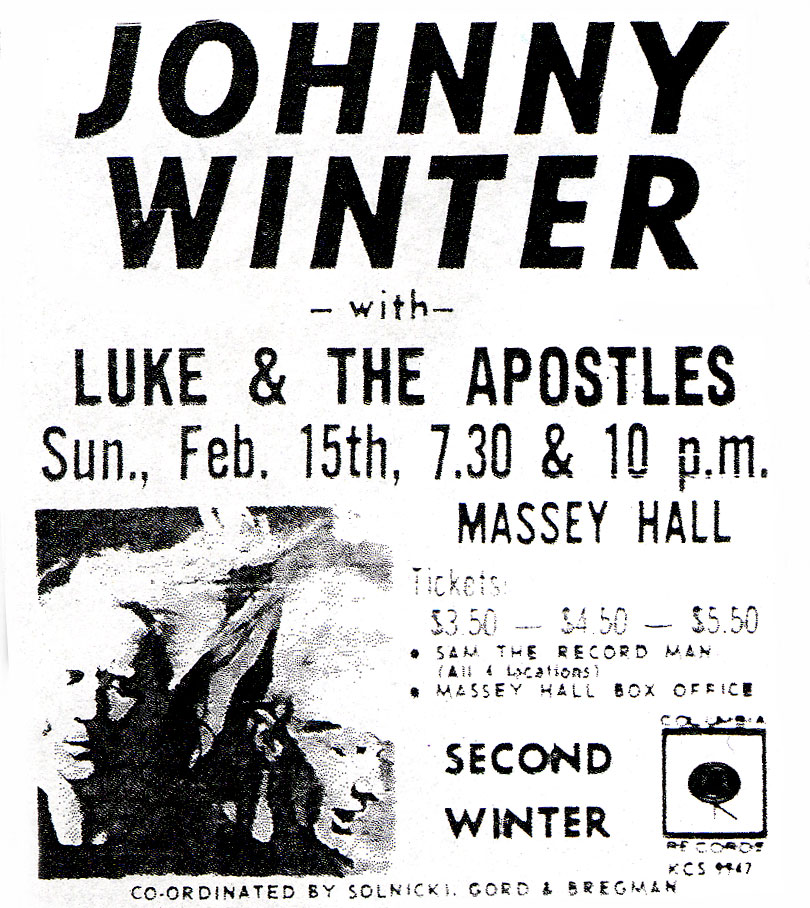
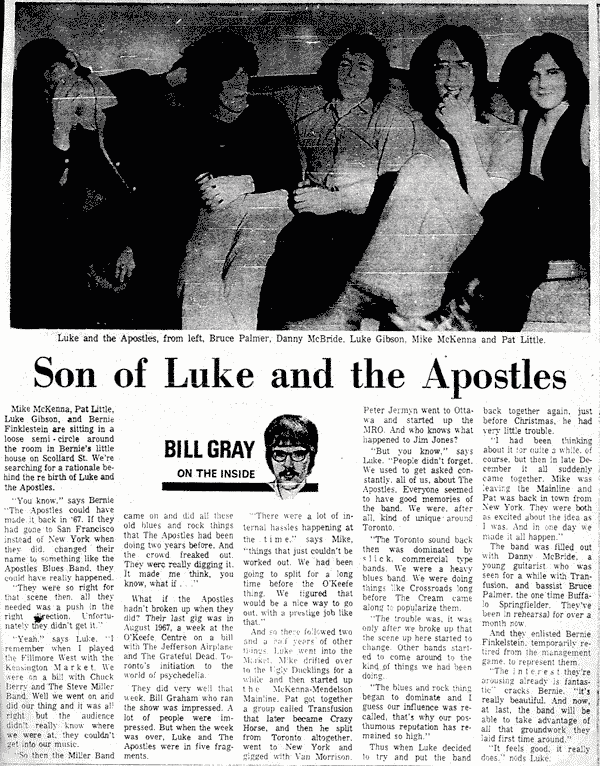

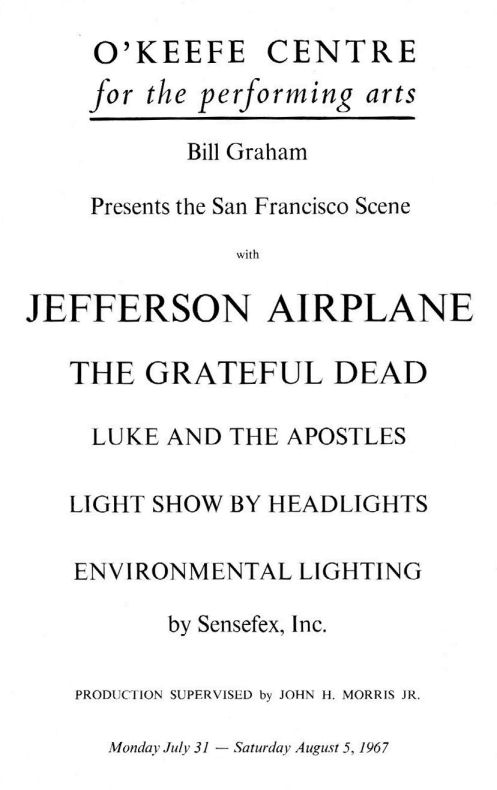

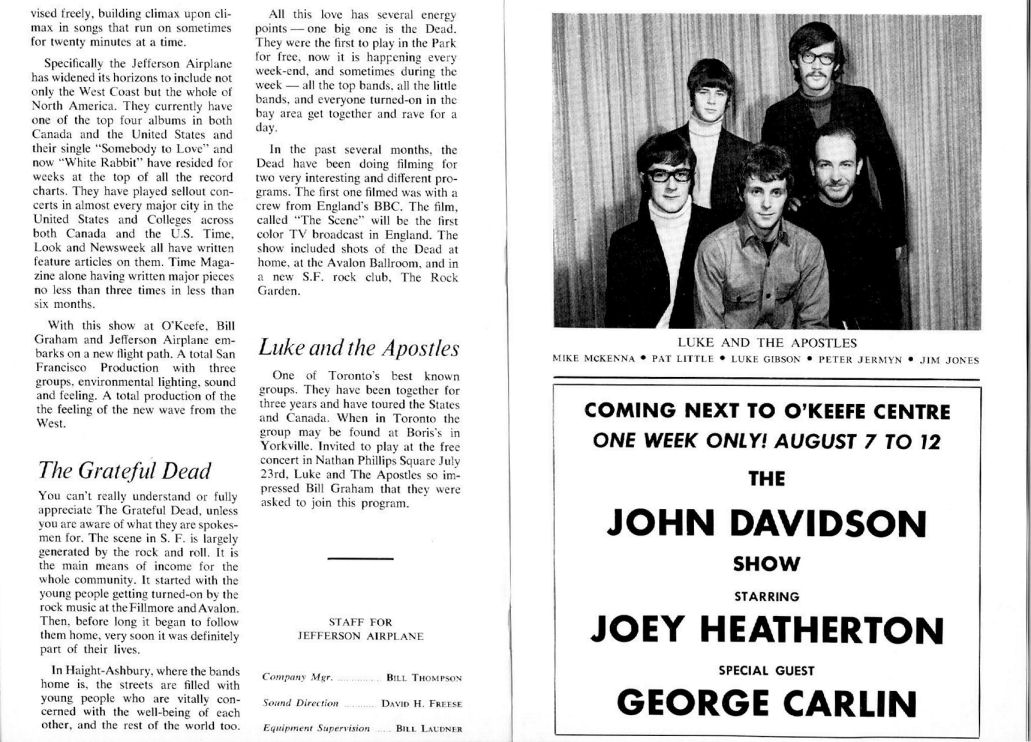
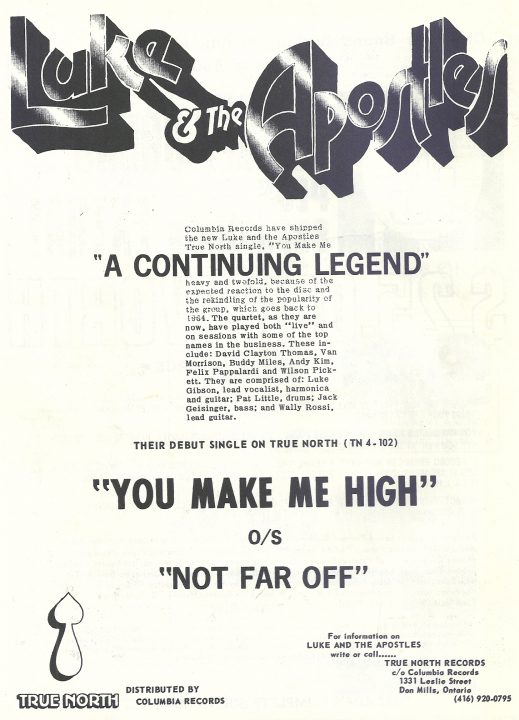
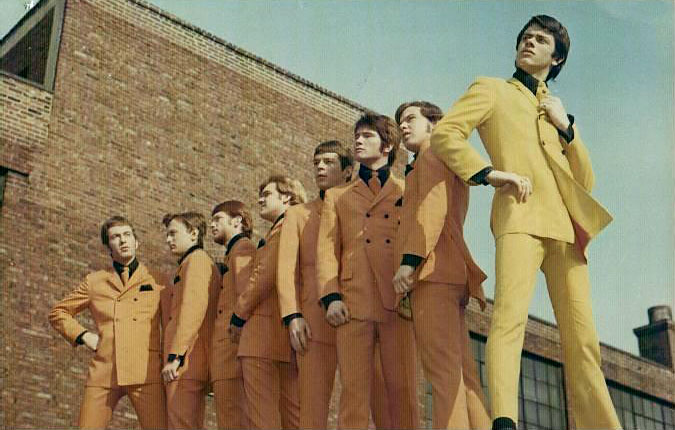
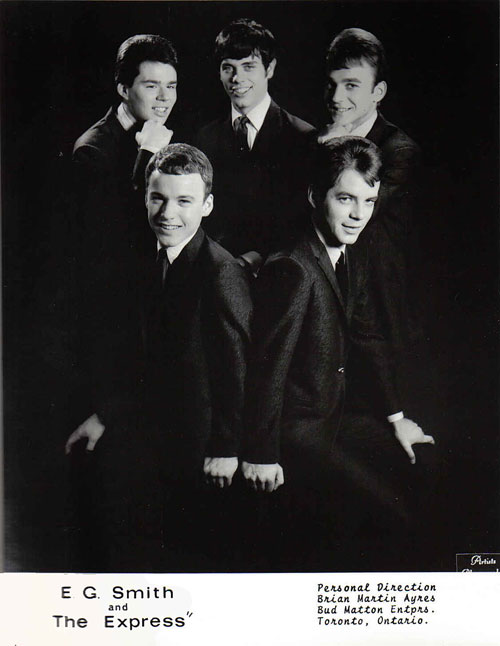
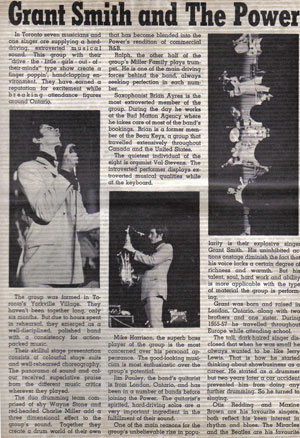
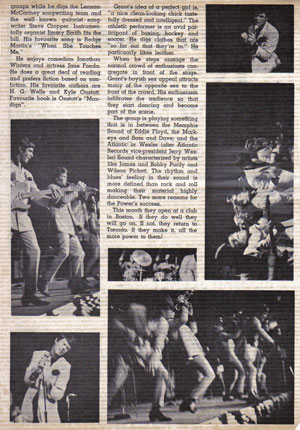
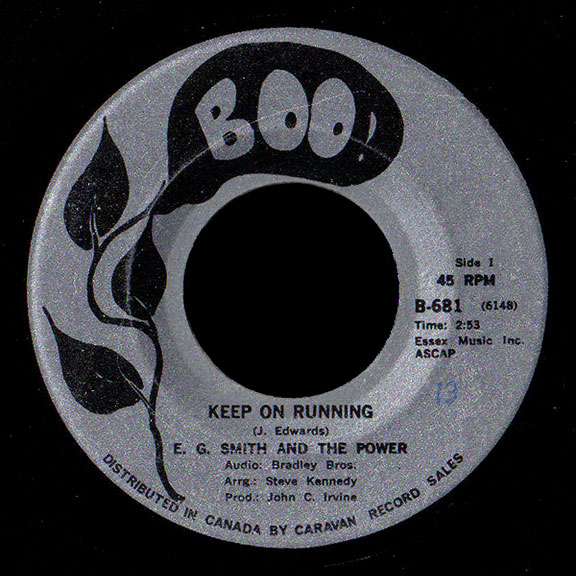
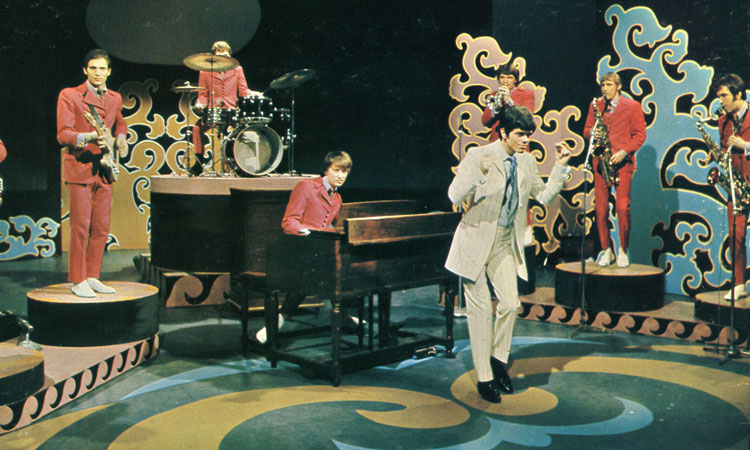
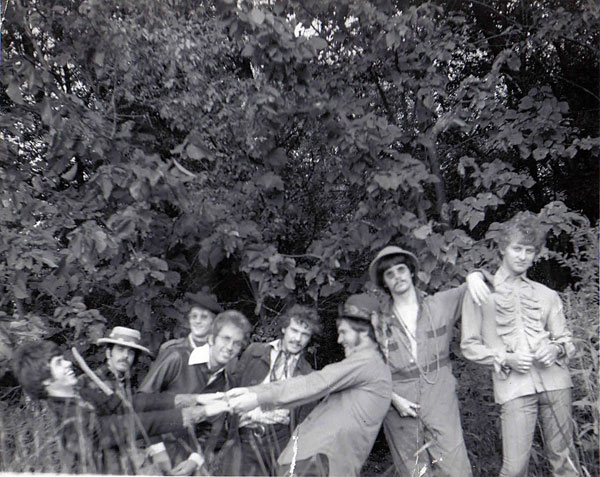

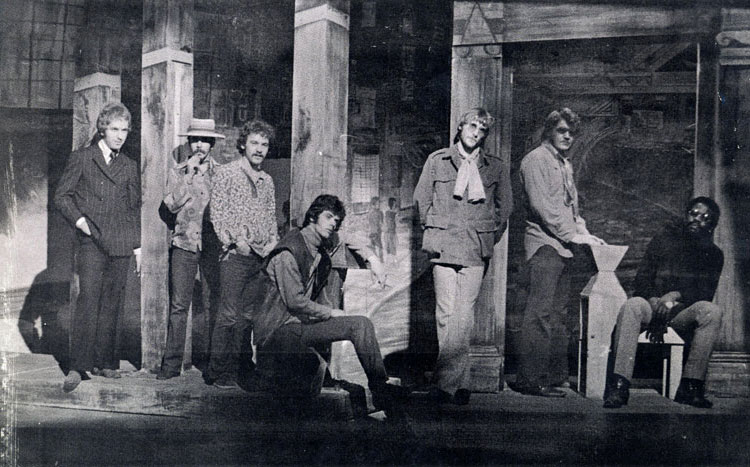
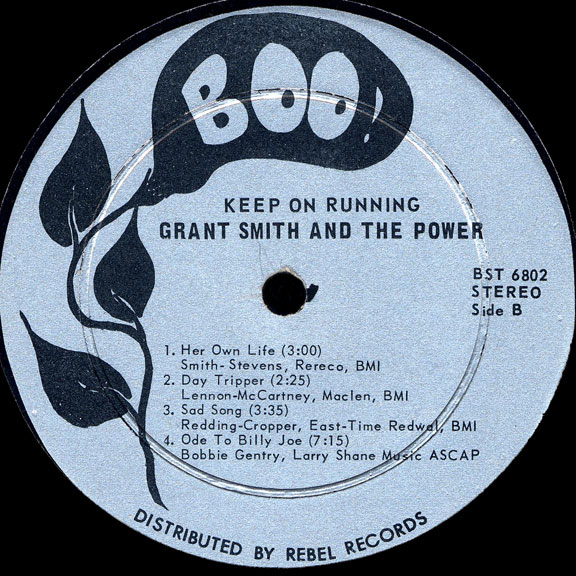
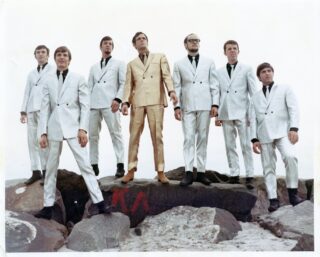
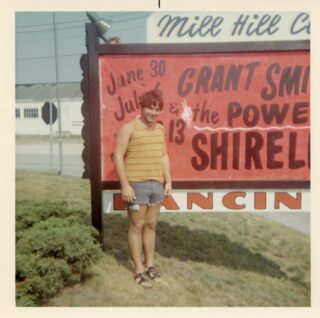

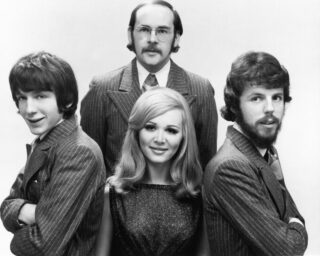
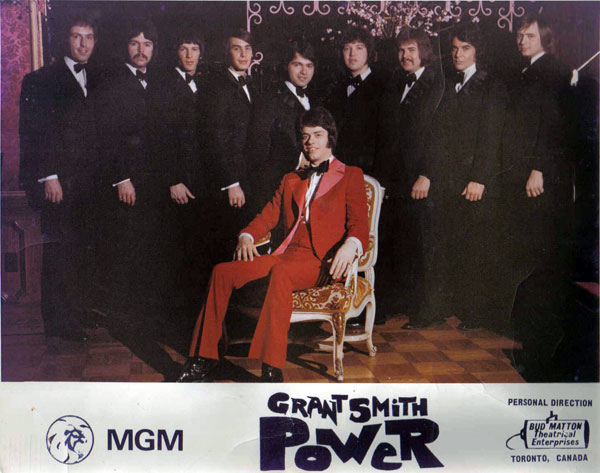
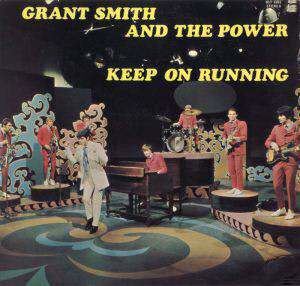
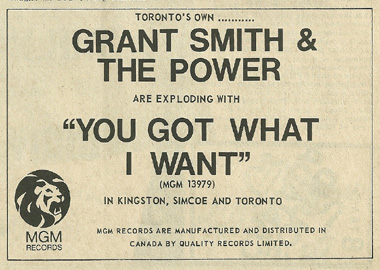
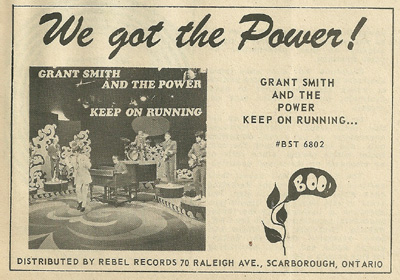
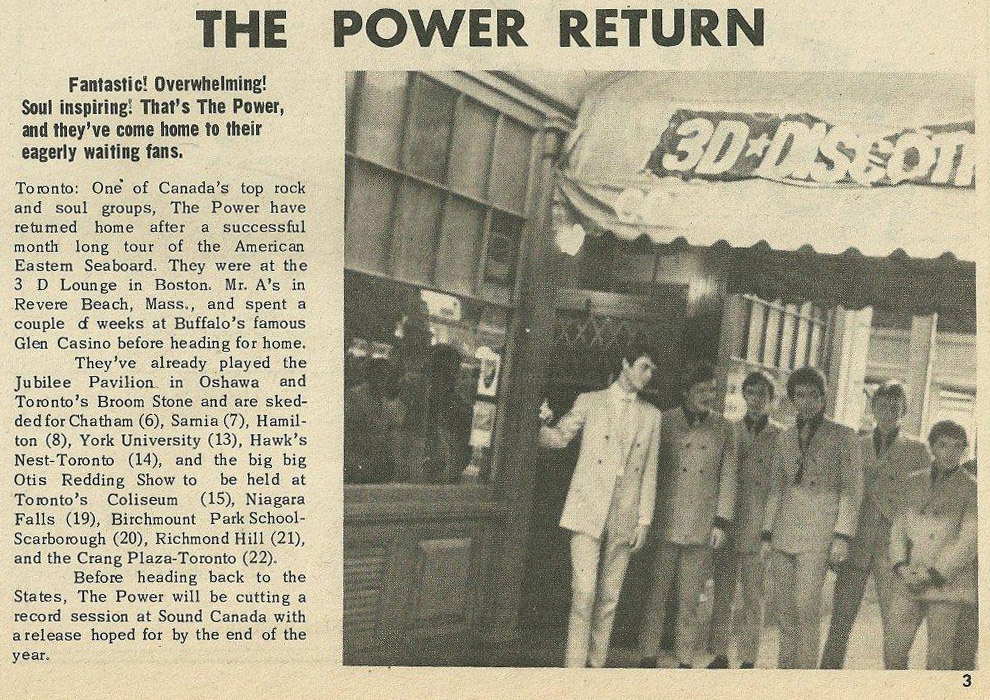
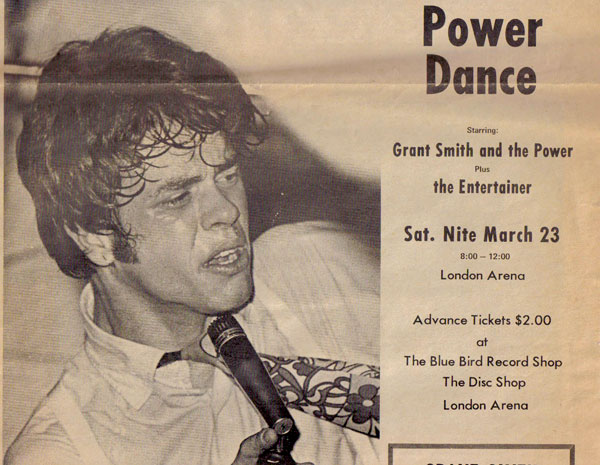
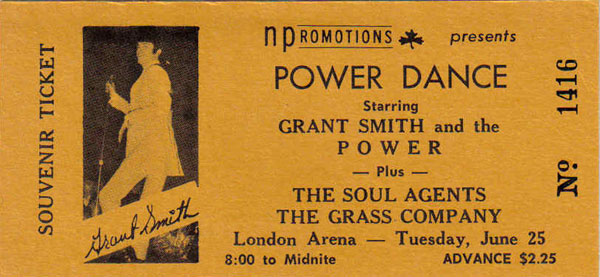
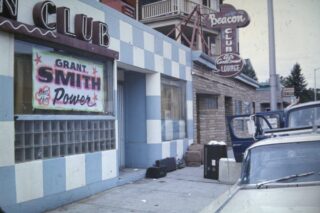
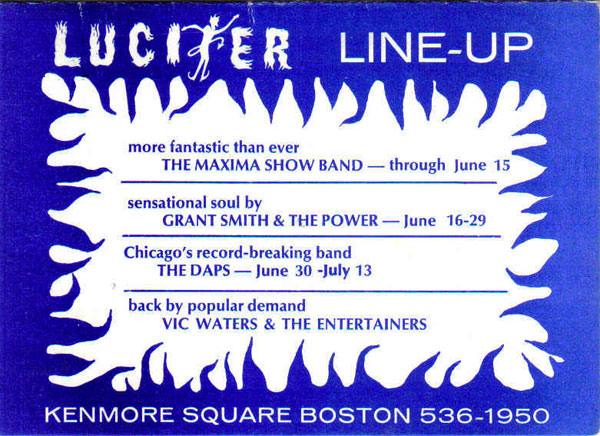

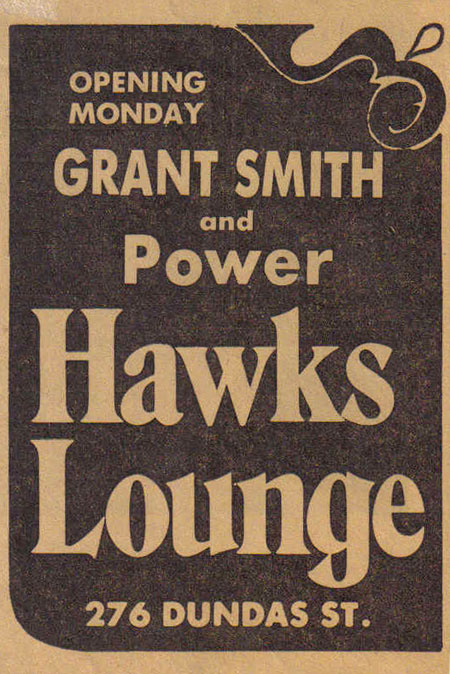
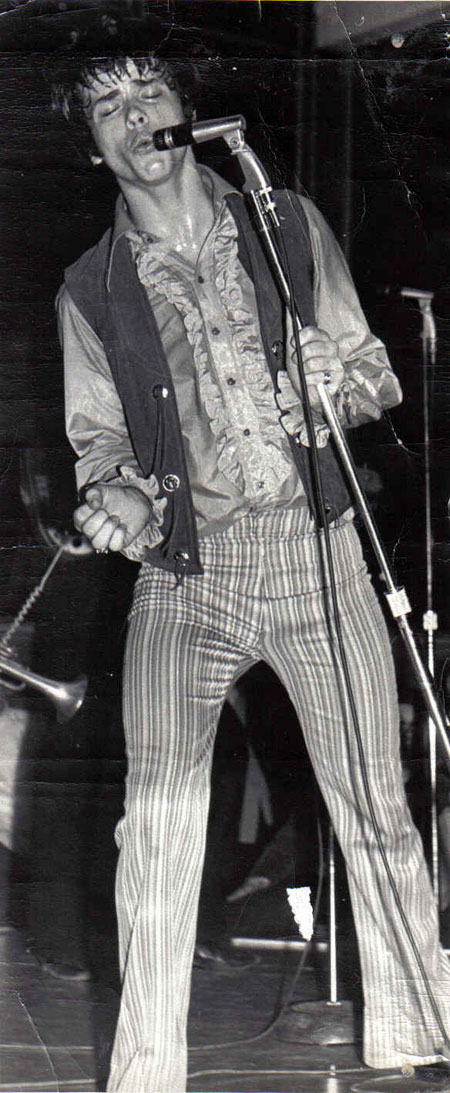

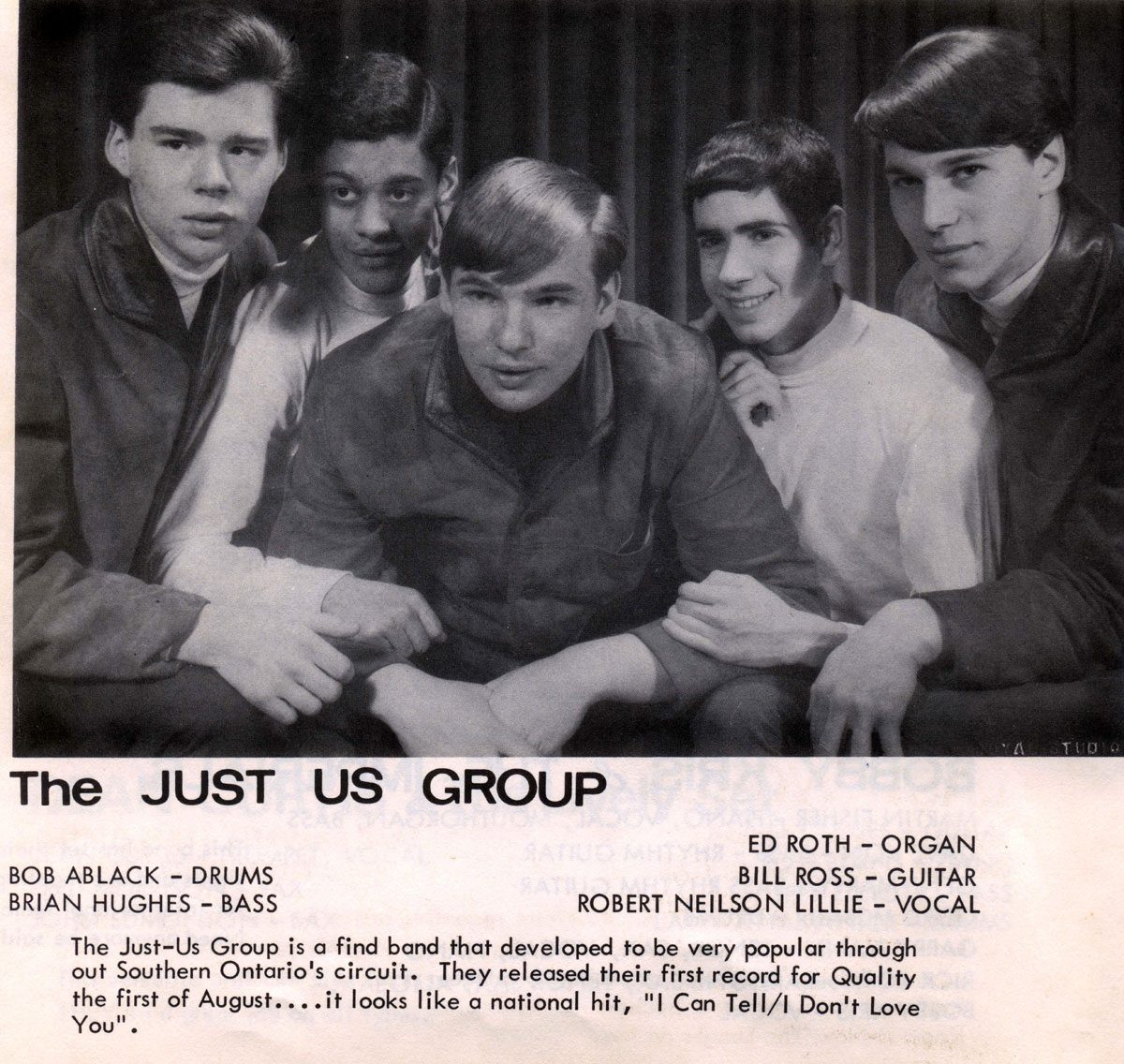

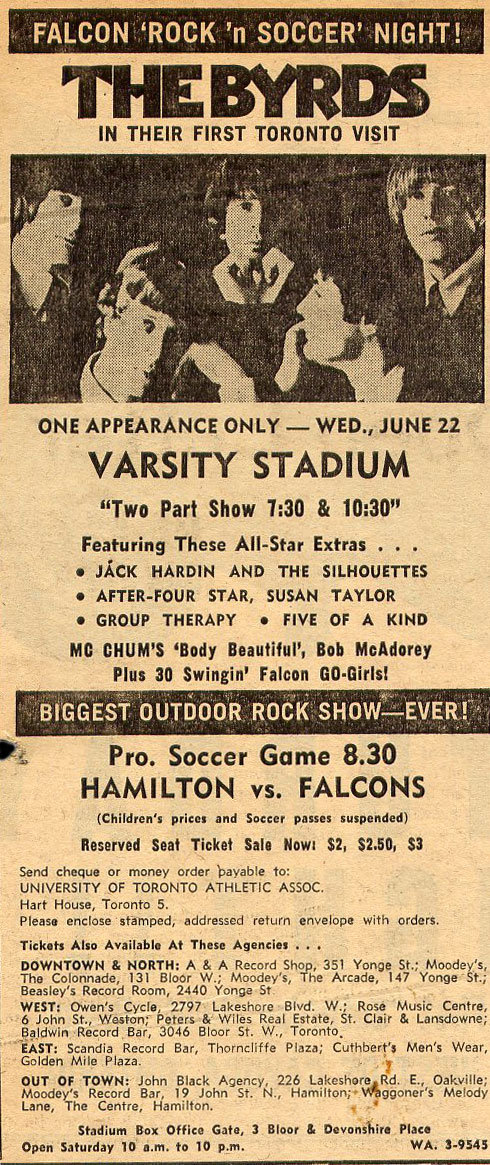
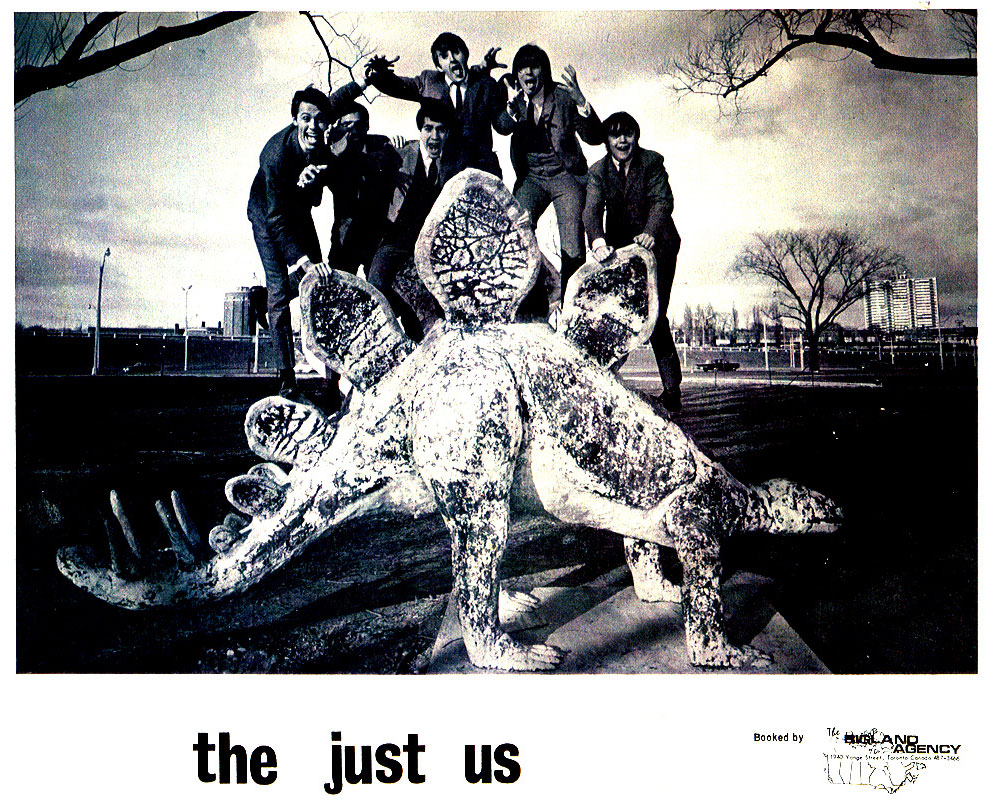
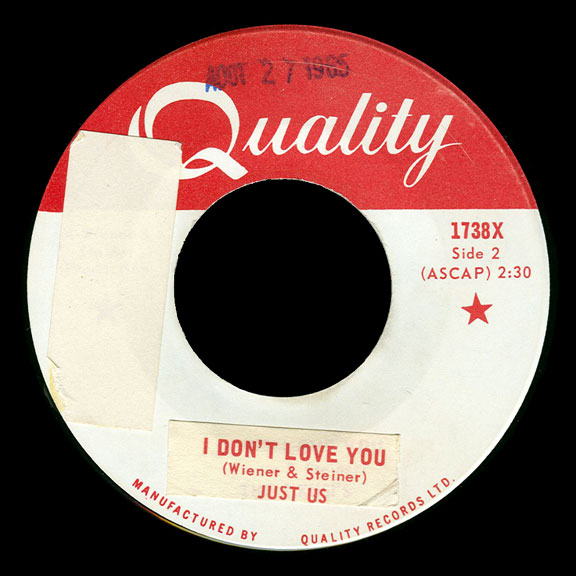
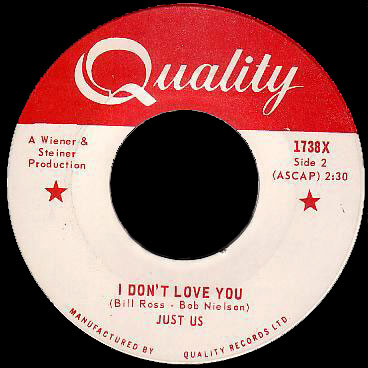

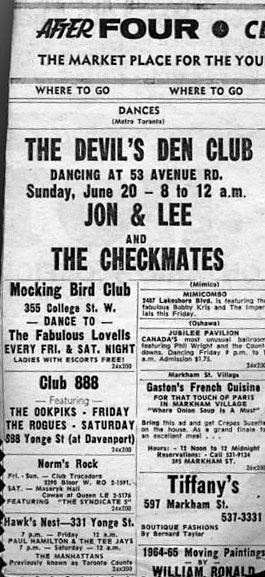
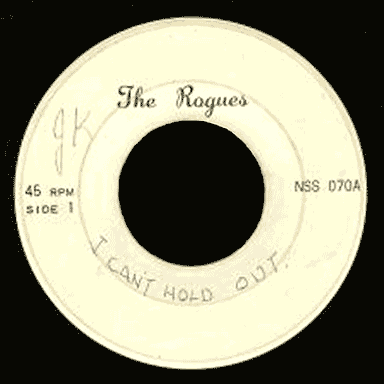
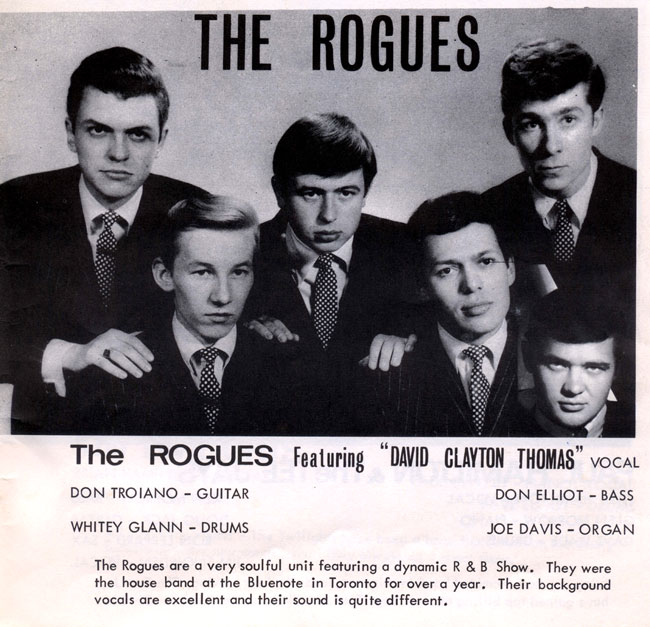
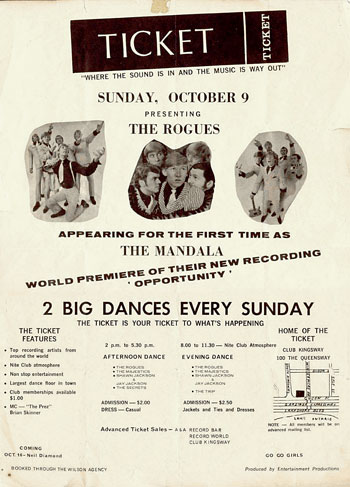
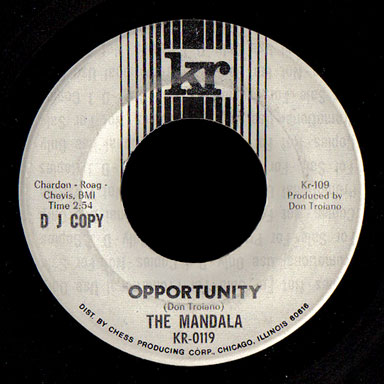
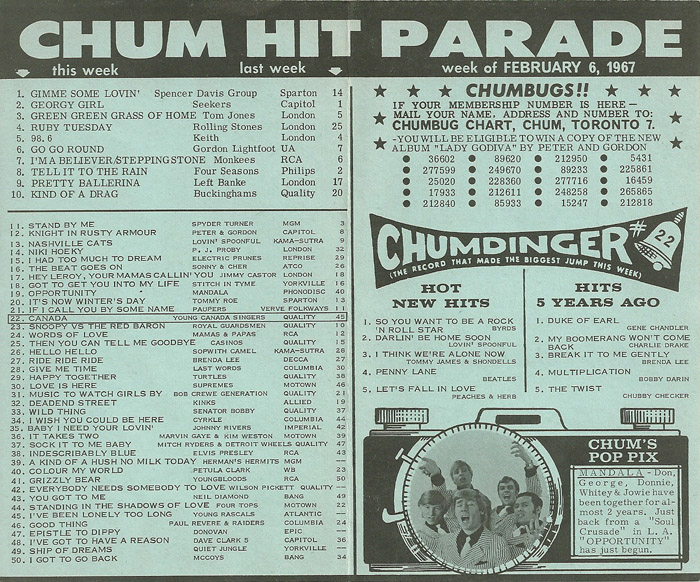
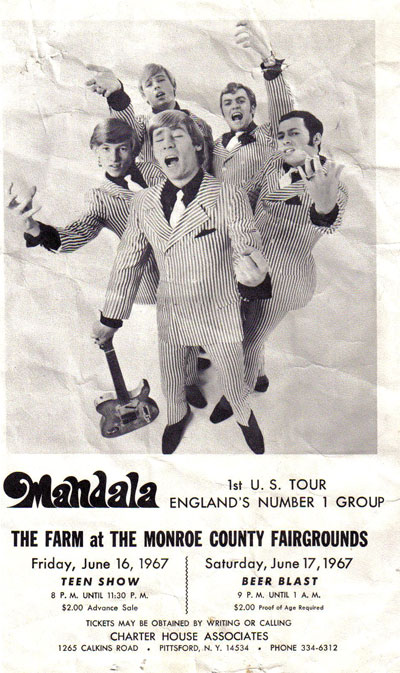
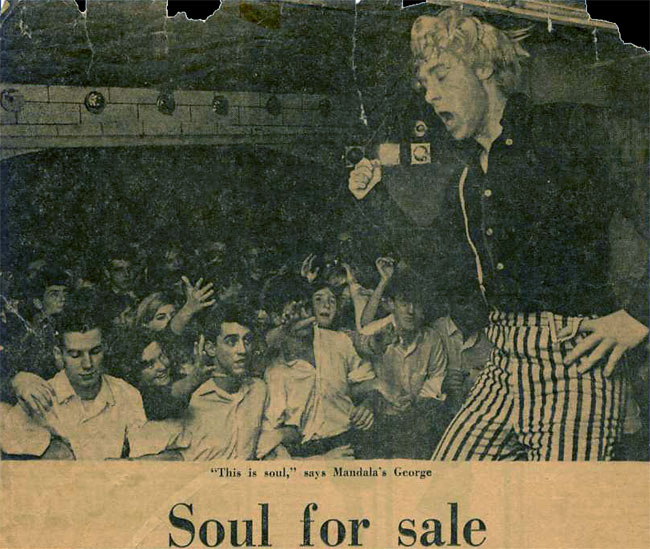

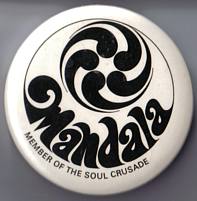
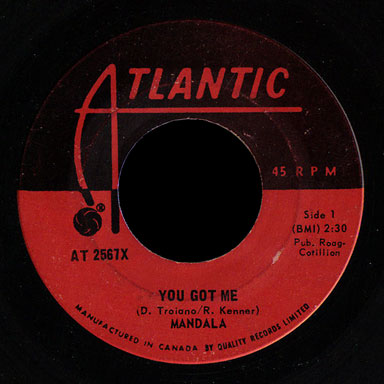 Despite gigging incessantly on the Toronto scene from December 1967-January 1969, and opening for The Hollies in Ottawa during March 1968, Olliver’s new group never recorded and in mid-1969, he emerged with a new outfit, Natural Gas, who recorded an album for Firebird Records in 1969 (the long player, incidentally, includes an Olliver-Chirowski instrumental from the Mandala repertoire, “Tribute to Rubber Boots”).
Despite gigging incessantly on the Toronto scene from December 1967-January 1969, and opening for The Hollies in Ottawa during March 1968, Olliver’s new group never recorded and in mid-1969, he emerged with a new outfit, Natural Gas, who recorded an album for Firebird Records in 1969 (the long player, incidentally, includes an Olliver-Chirowski instrumental from the Mandala repertoire, “Tribute to Rubber Boots”).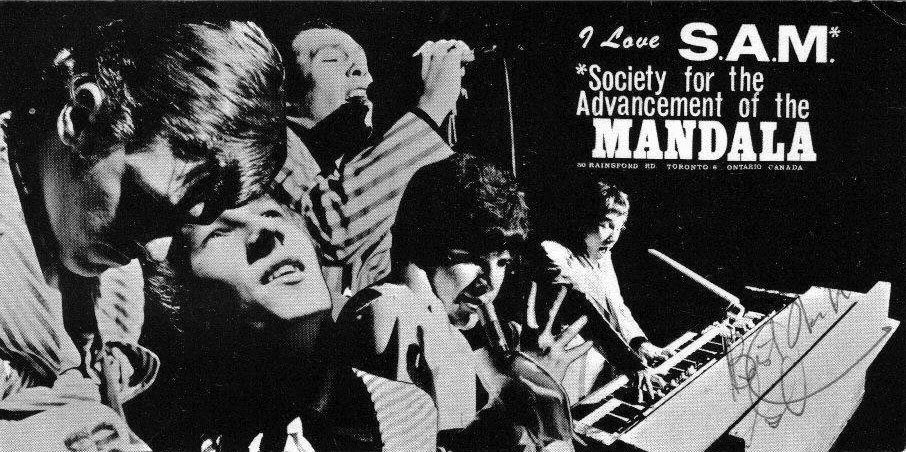
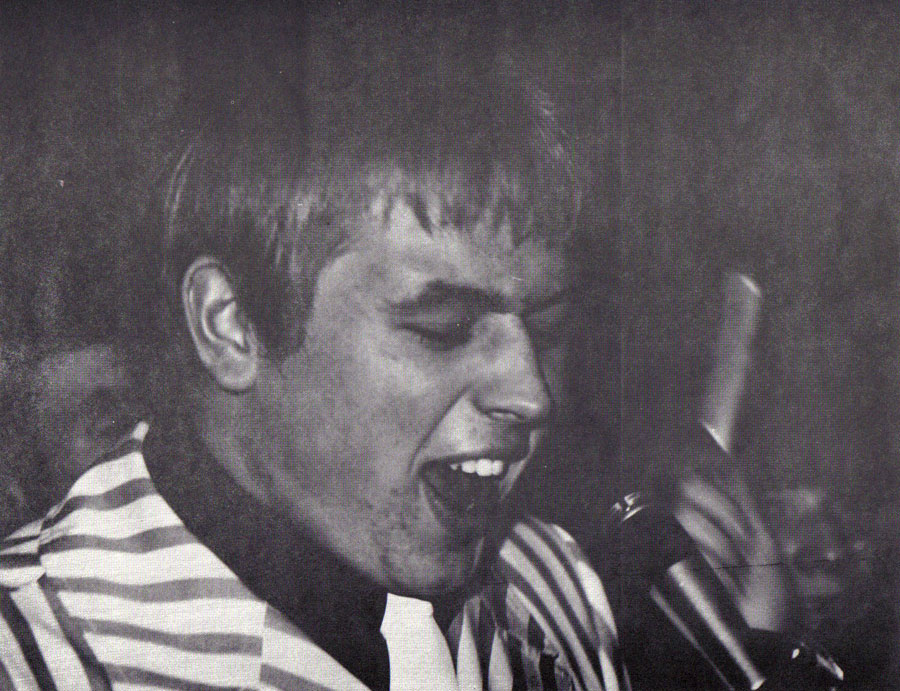
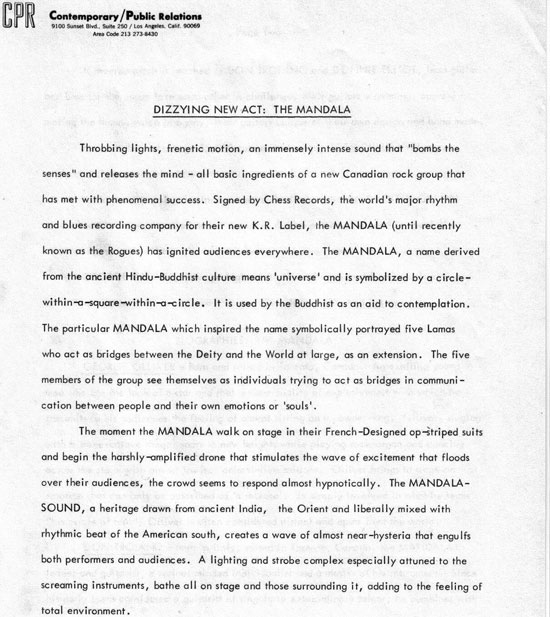
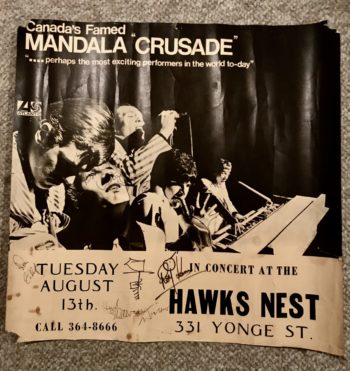
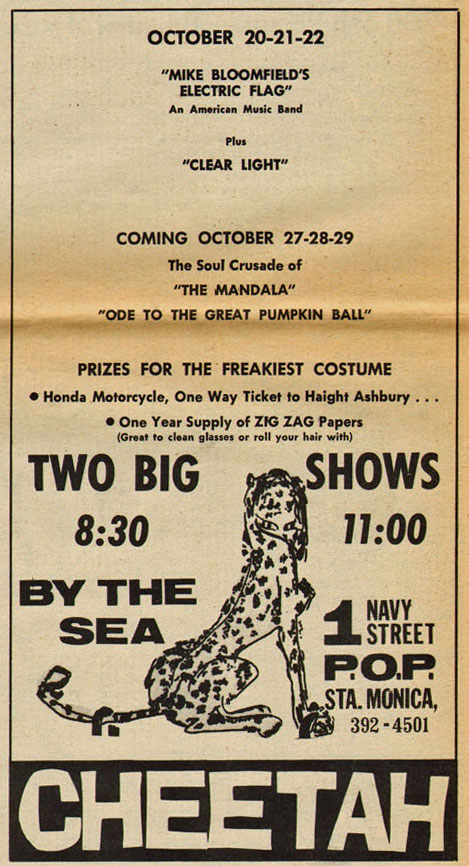

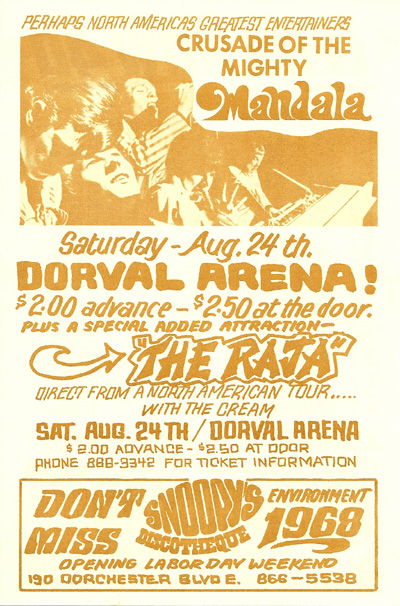

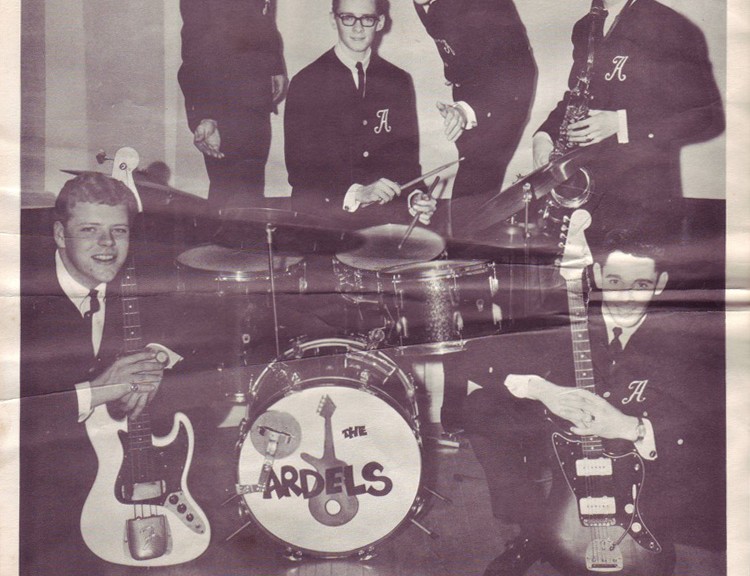
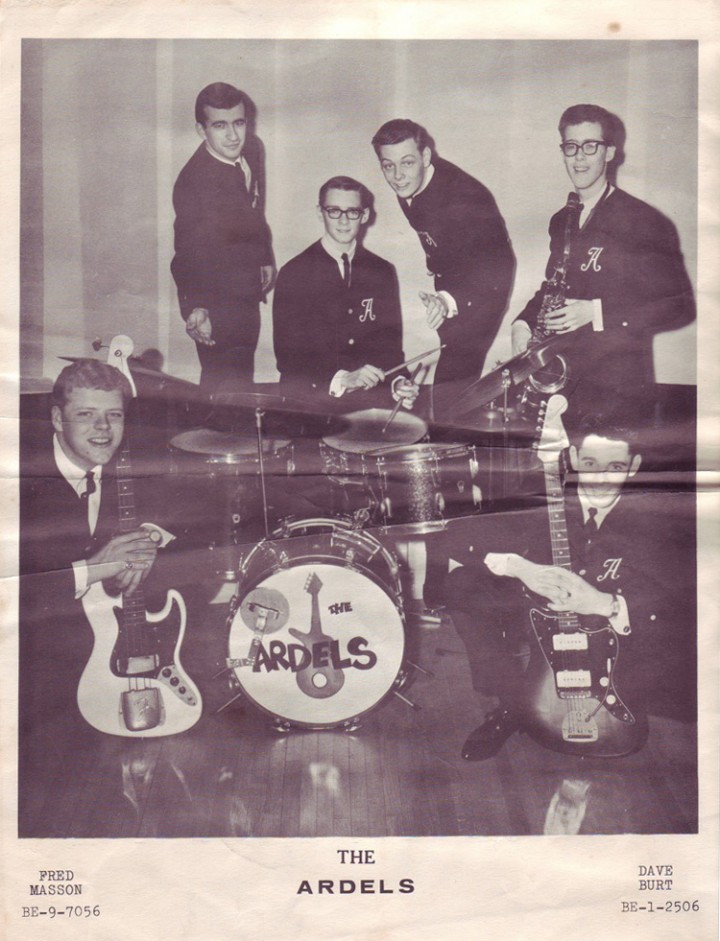
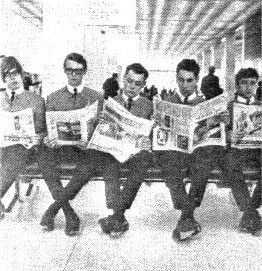
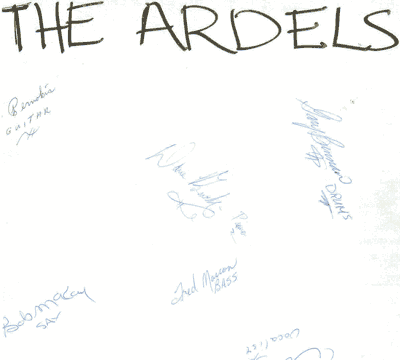
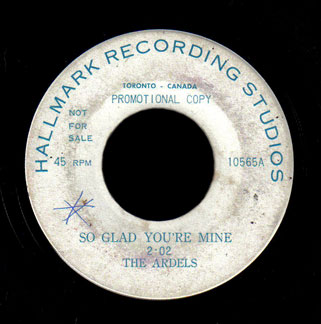
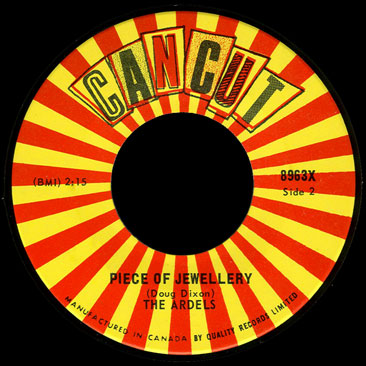


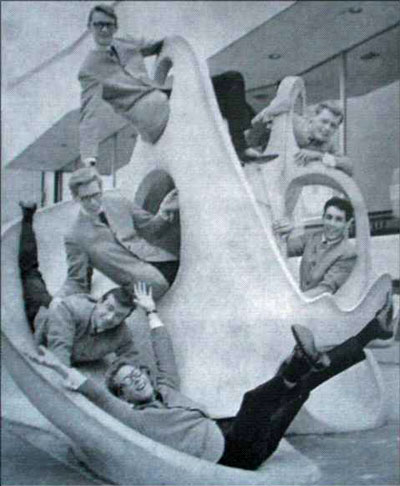

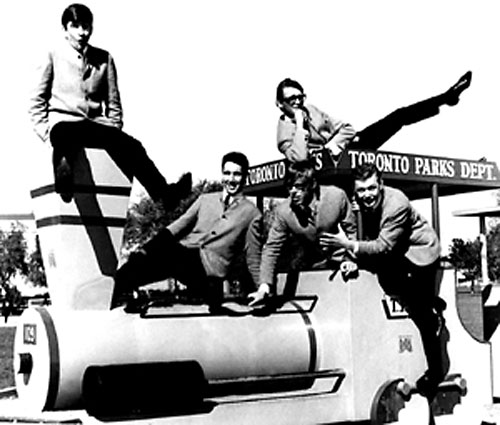
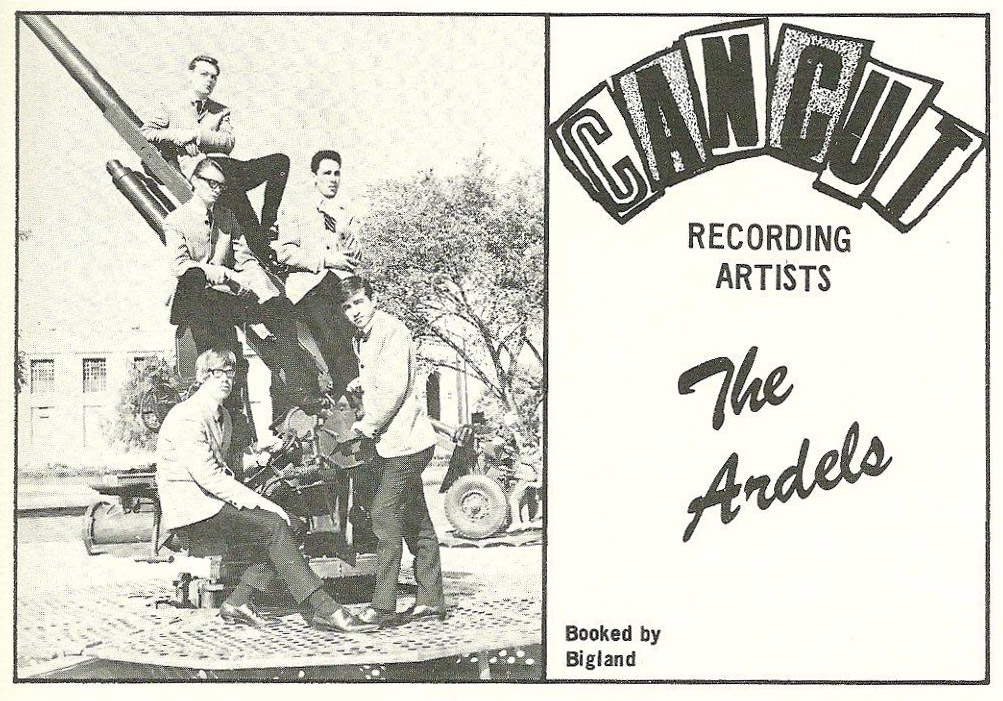
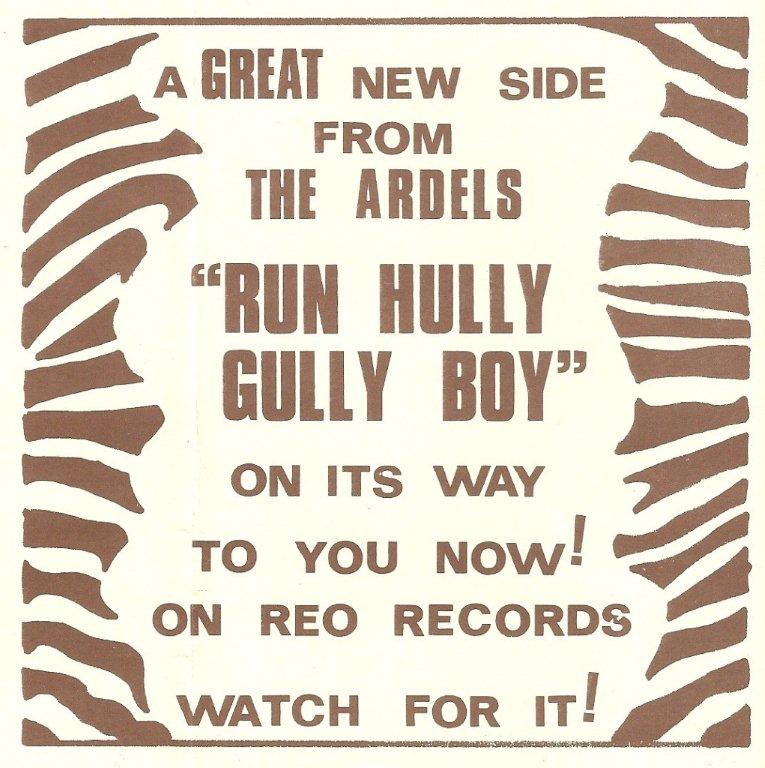
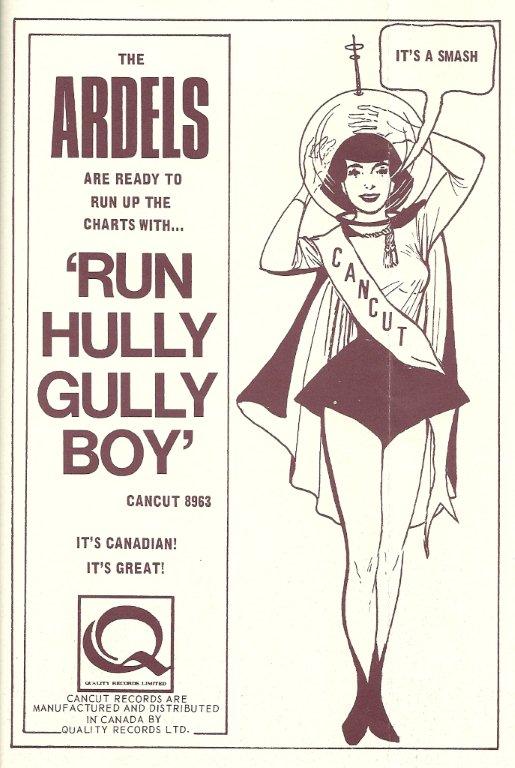


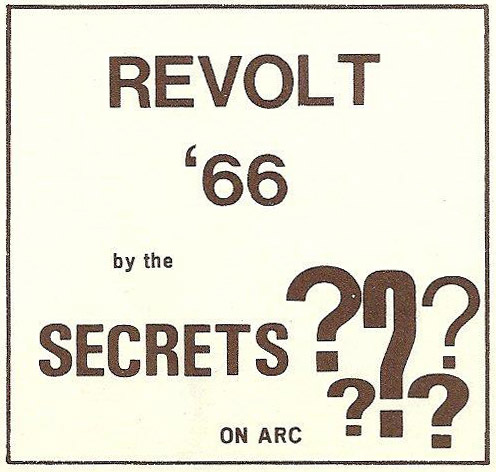
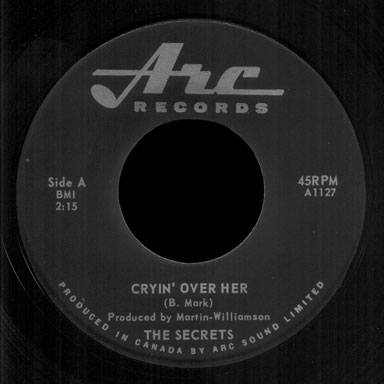
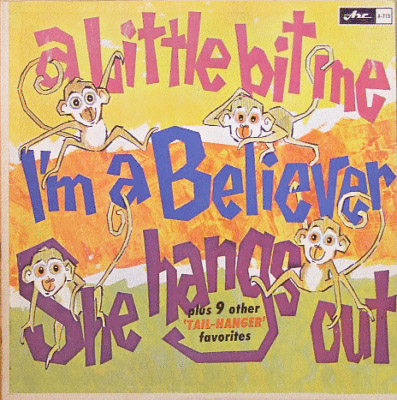
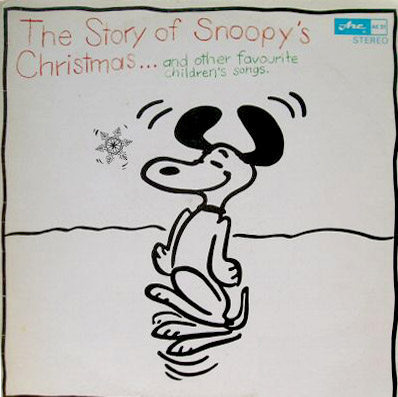
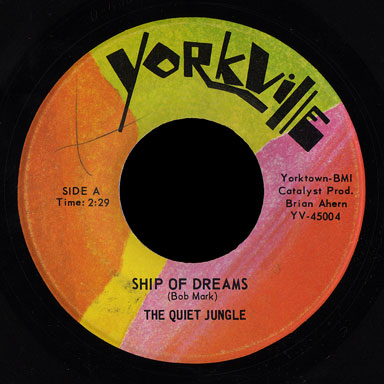
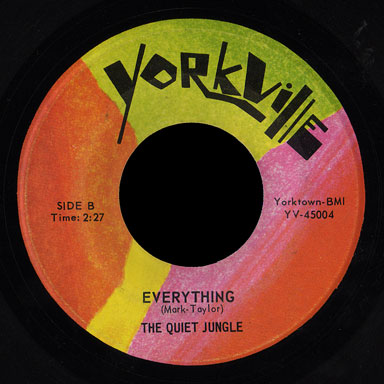
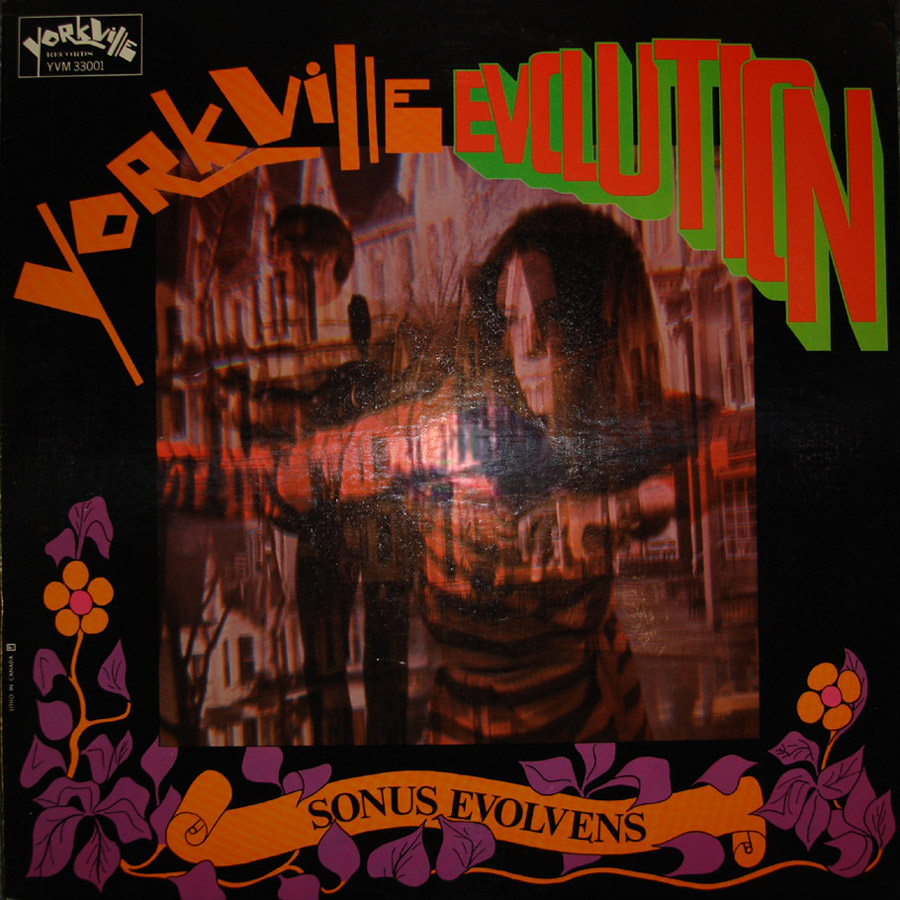
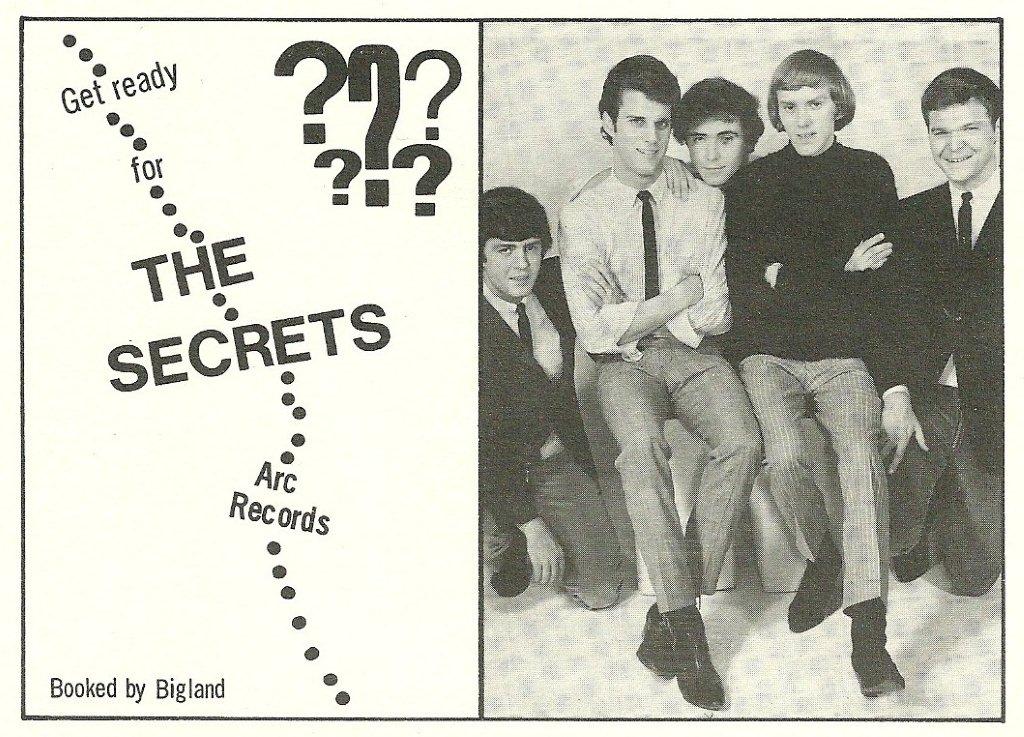
 No we had nothing to do with the “Flower Power” album. There were a couple of TV shows at that time called After Four and High Time that were on CTV. We were on those shows varily often. There was an album produced at the time called “After Four”. There are some great tracks on that album from the Ugly Duckings, Big Town Boys and Stitch In Tyme to name a few. At the time of the album we recorded a song entitled “Four In the Morning”. Without going into a lot of detail, we recorded it under the name of the Scarlet Ribbon.
No we had nothing to do with the “Flower Power” album. There were a couple of TV shows at that time called After Four and High Time that were on CTV. We were on those shows varily often. There was an album produced at the time called “After Four”. There are some great tracks on that album from the Ugly Duckings, Big Town Boys and Stitch In Tyme to name a few. At the time of the album we recorded a song entitled “Four In the Morning”. Without going into a lot of detail, we recorded it under the name of the Scarlet Ribbon.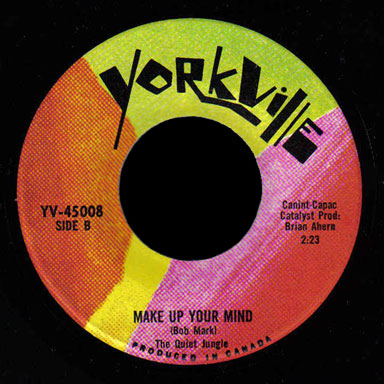 There were a few reasons the band broke up. After four years (having the time of my life), I came to the realization that “I personally” was not a good enough singer to hit the big time. While traveling the country, I got to hear bands and singers that were 10 times better than I was and realized that even they would not make it. We were playing the “Red River Exhibition” in Winnipeg one summer when I got to hear a young guy by the name of Burton Cummings sing. As soon as he opened his mouth, I knew I was in the wrong business. There was no mistaking, he had a voice from the Gods and was truly destined for stardom.
There were a few reasons the band broke up. After four years (having the time of my life), I came to the realization that “I personally” was not a good enough singer to hit the big time. While traveling the country, I got to hear bands and singers that were 10 times better than I was and realized that even they would not make it. We were playing the “Red River Exhibition” in Winnipeg one summer when I got to hear a young guy by the name of Burton Cummings sing. As soon as he opened his mouth, I knew I was in the wrong business. There was no mistaking, he had a voice from the Gods and was truly destined for stardom.